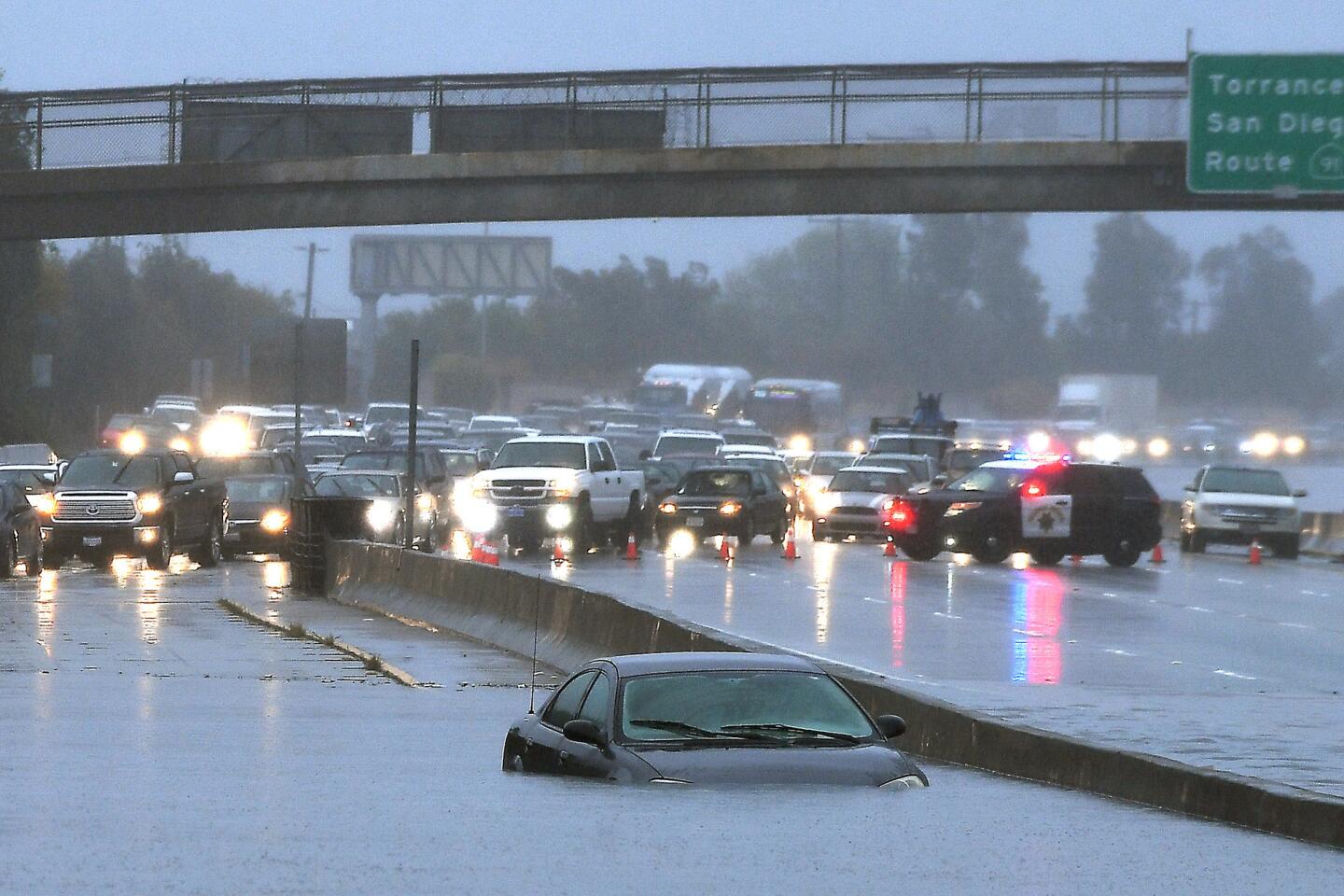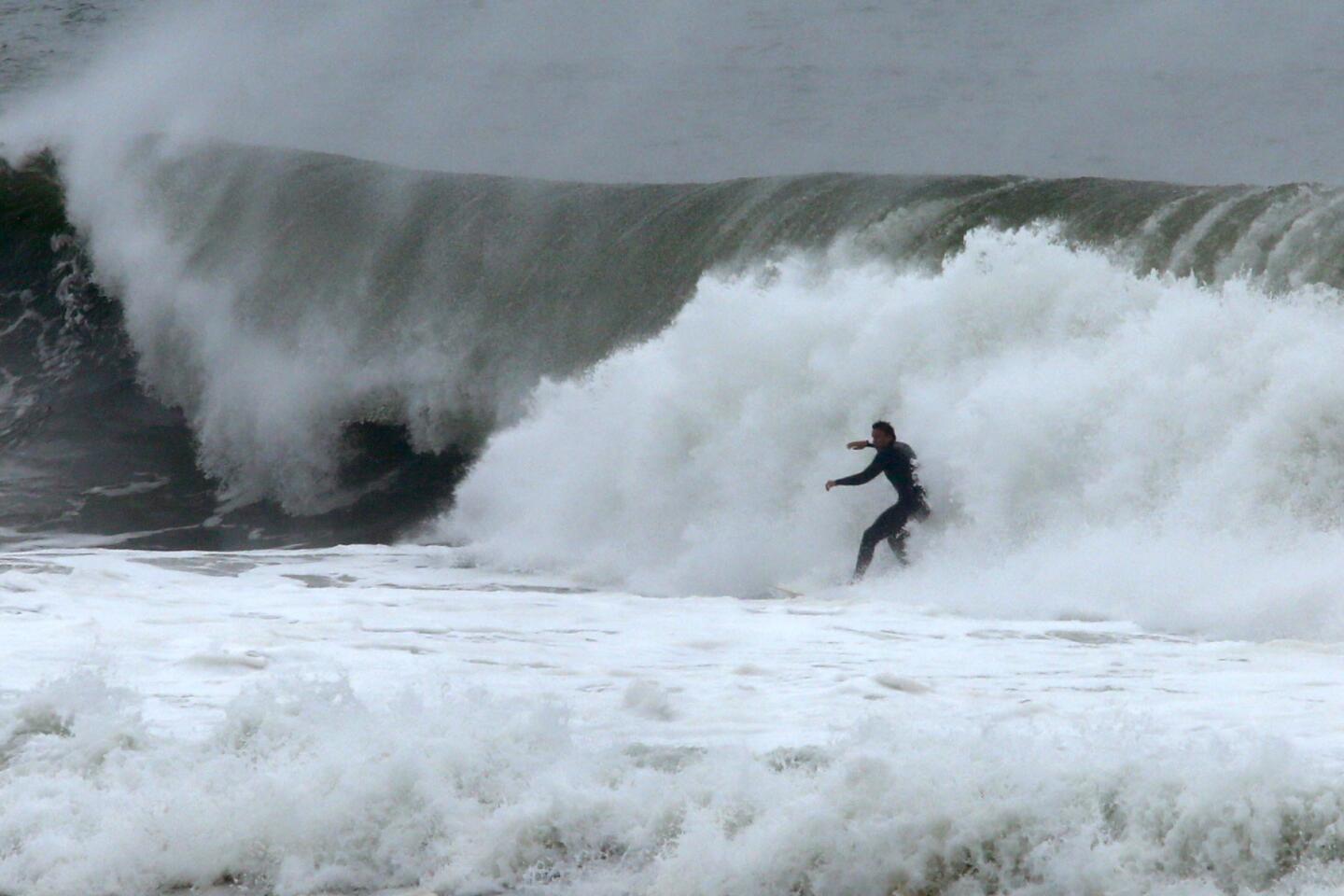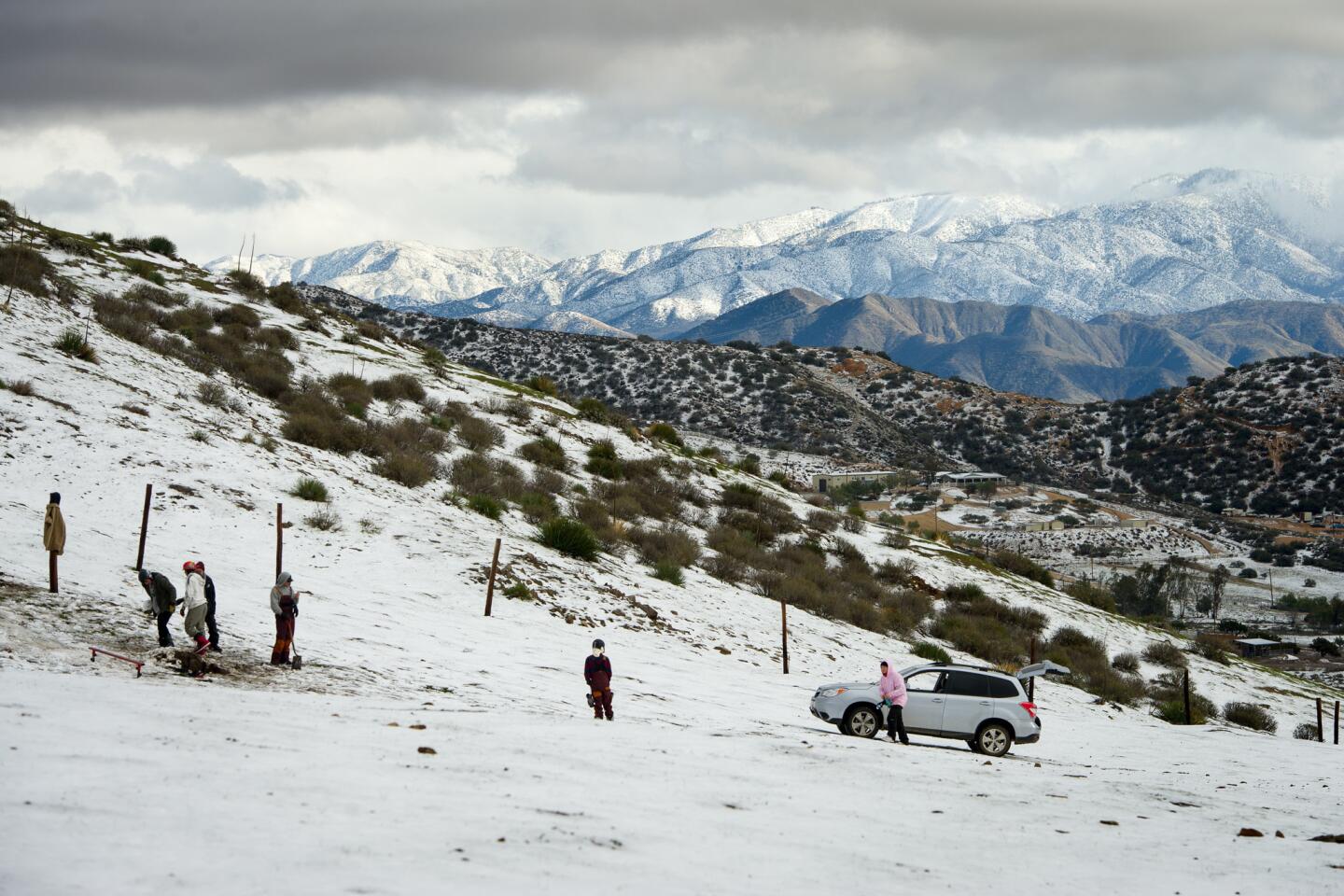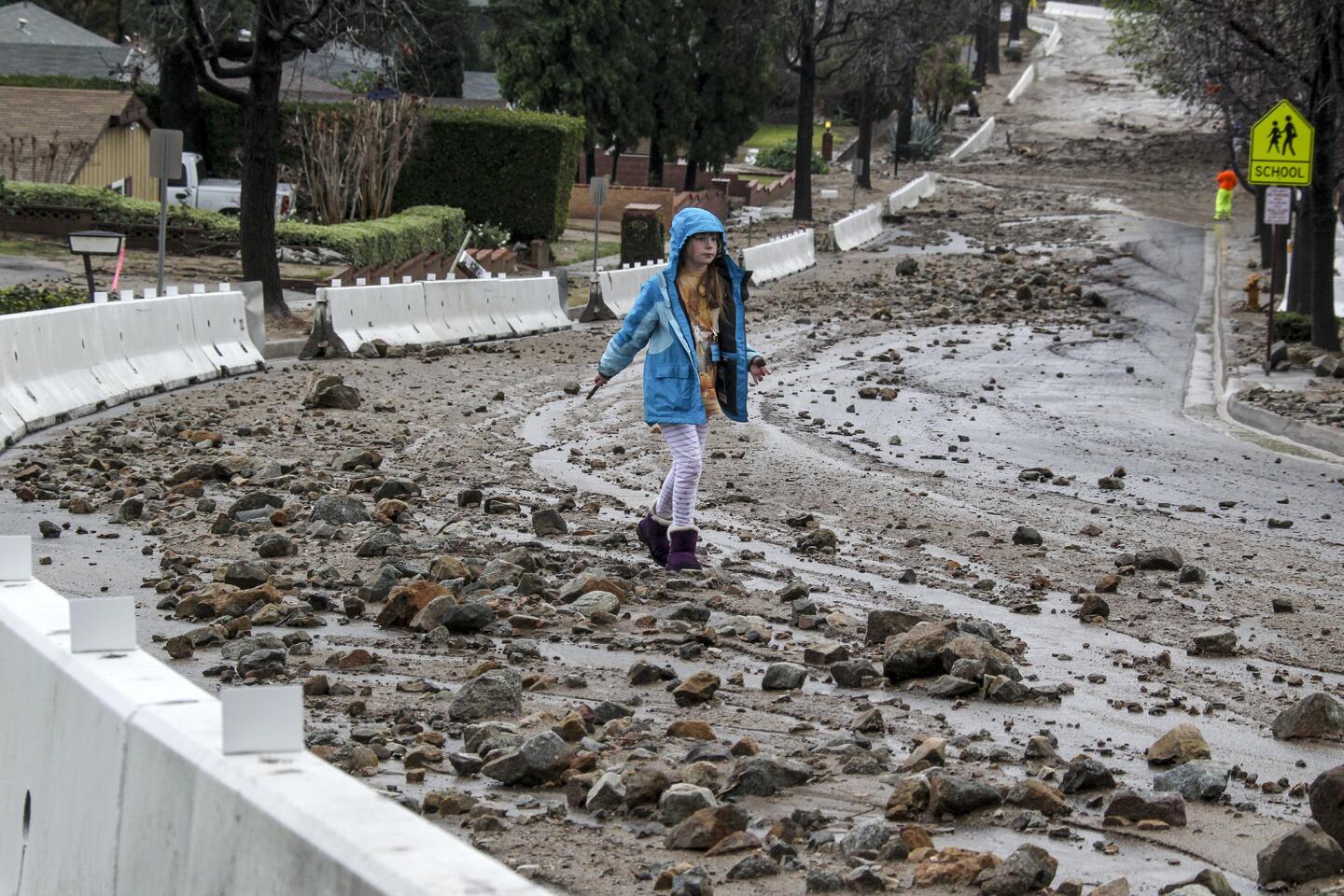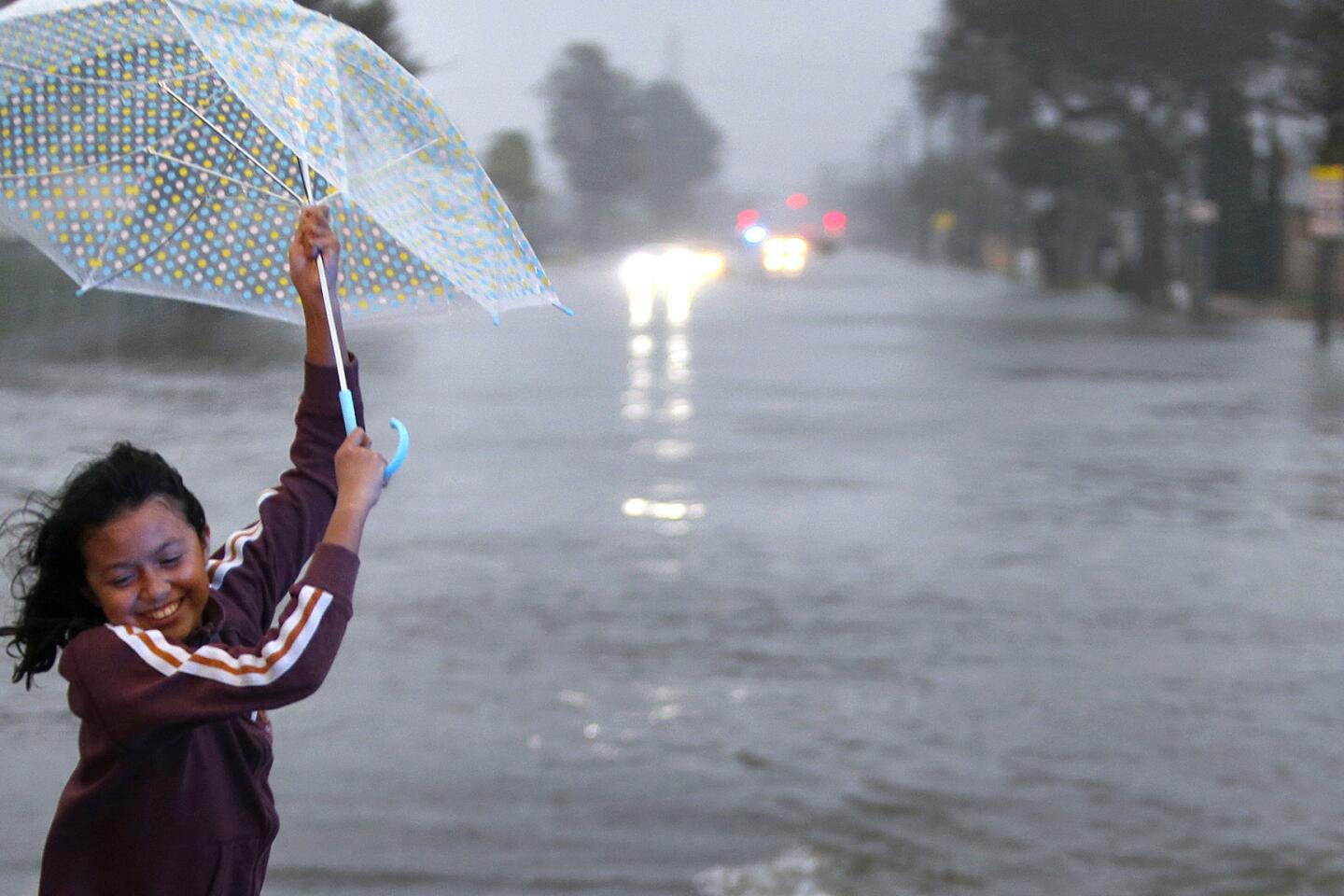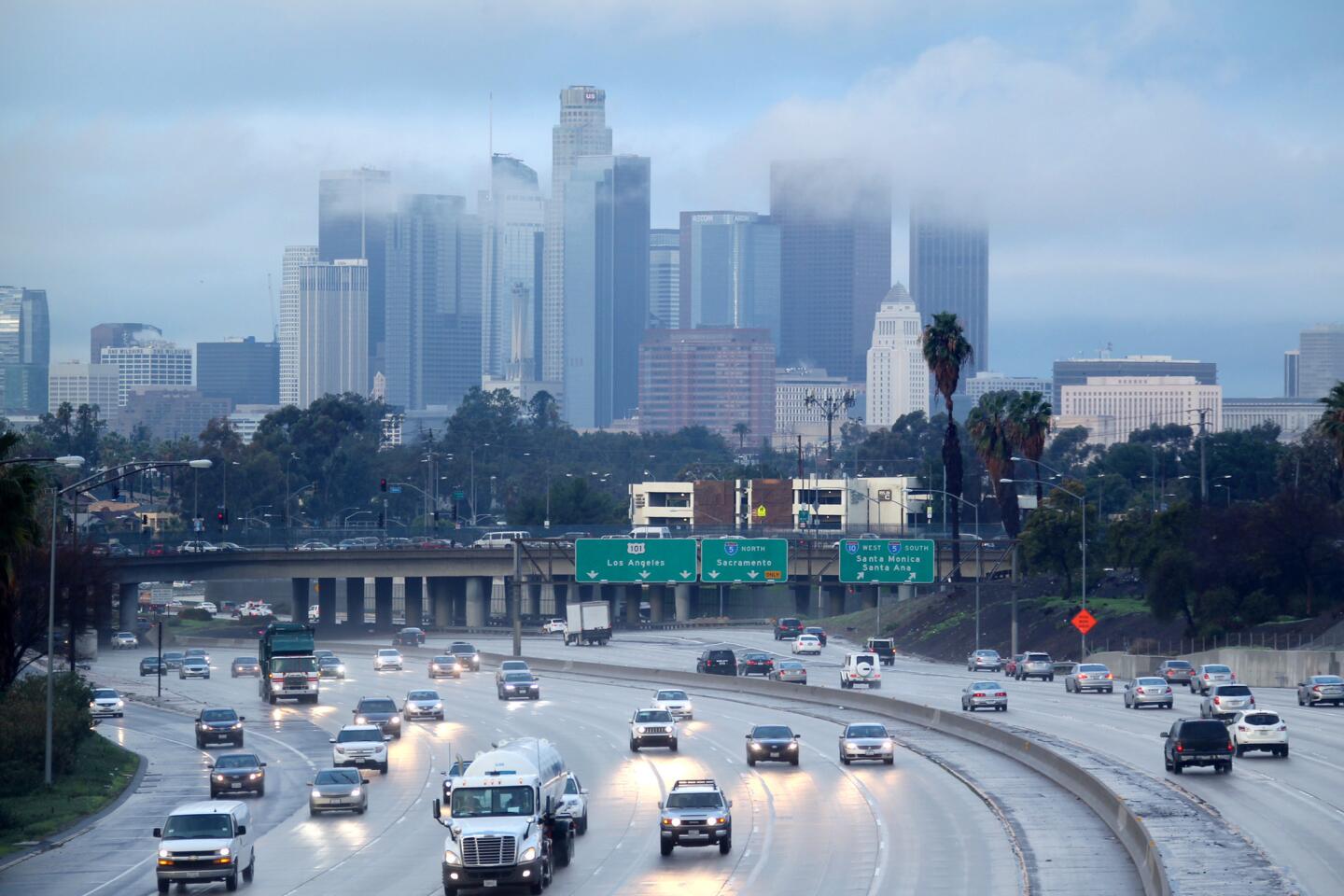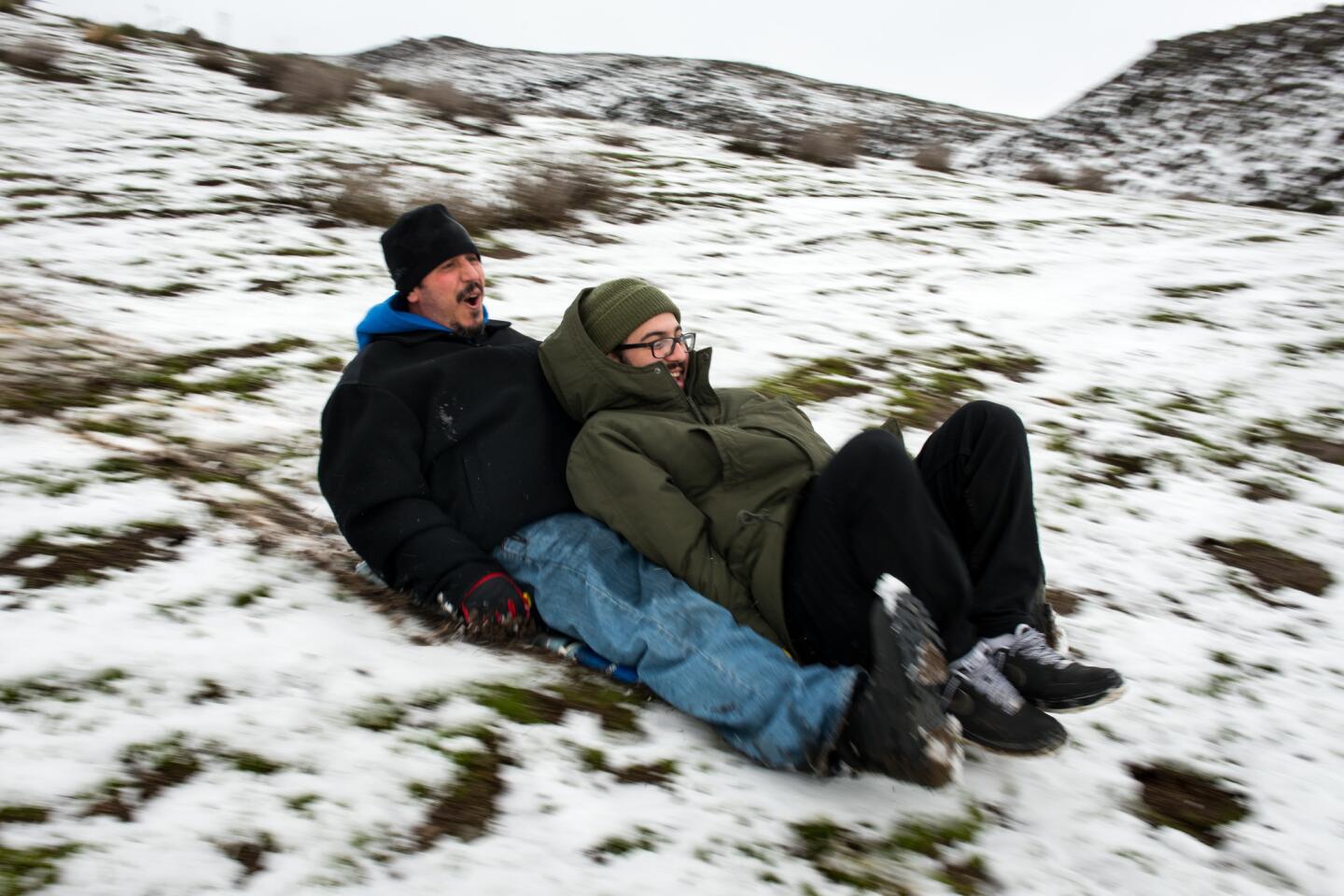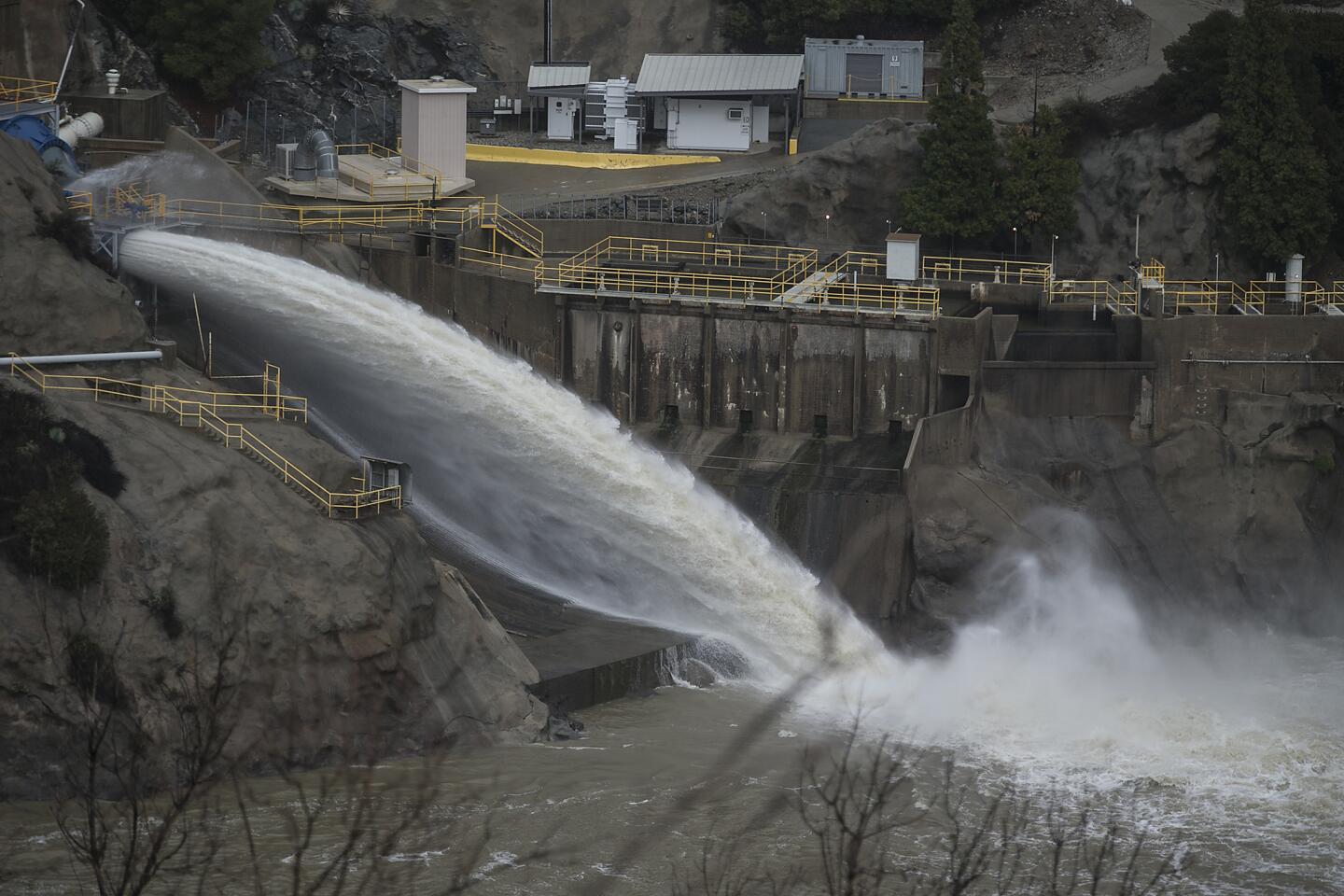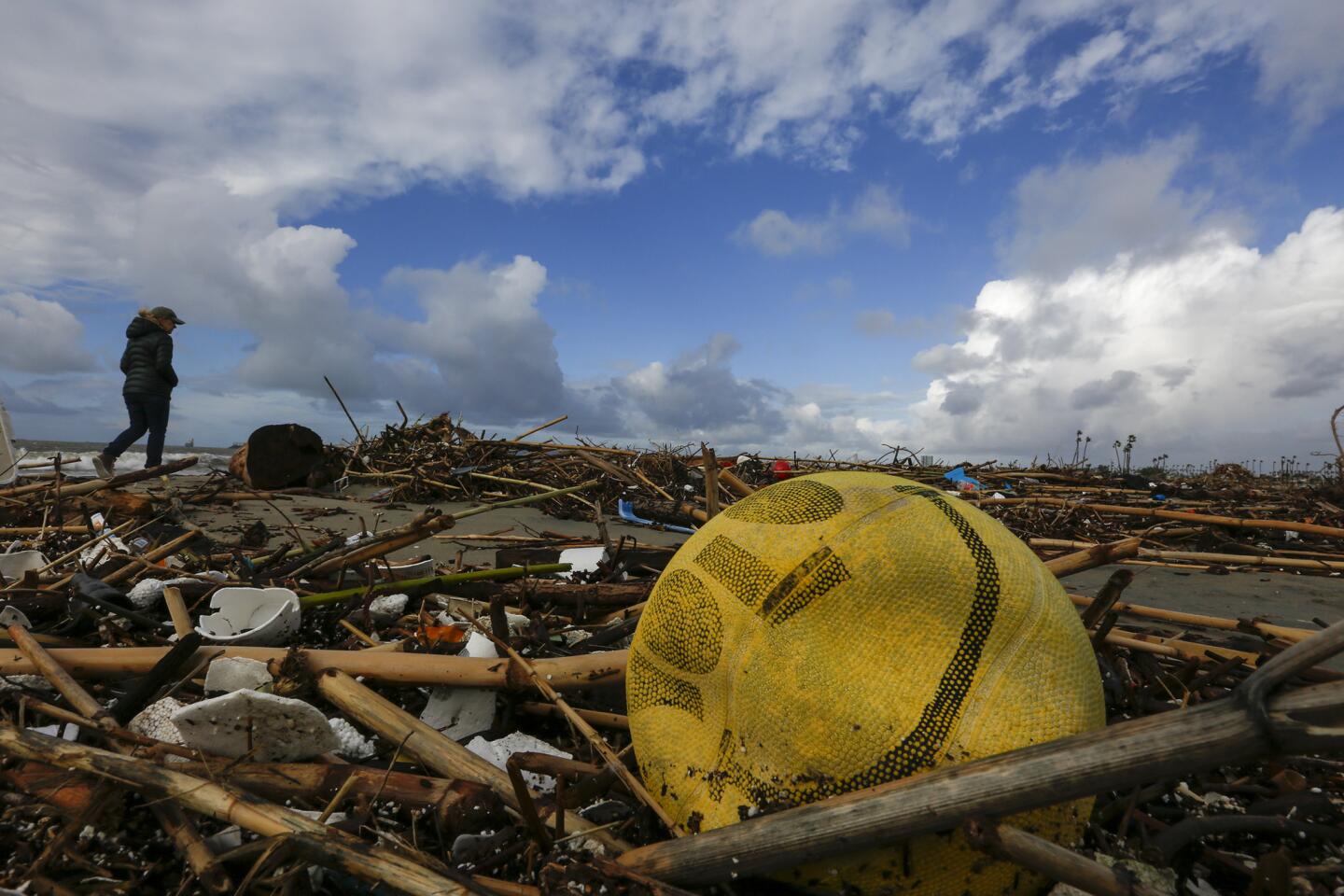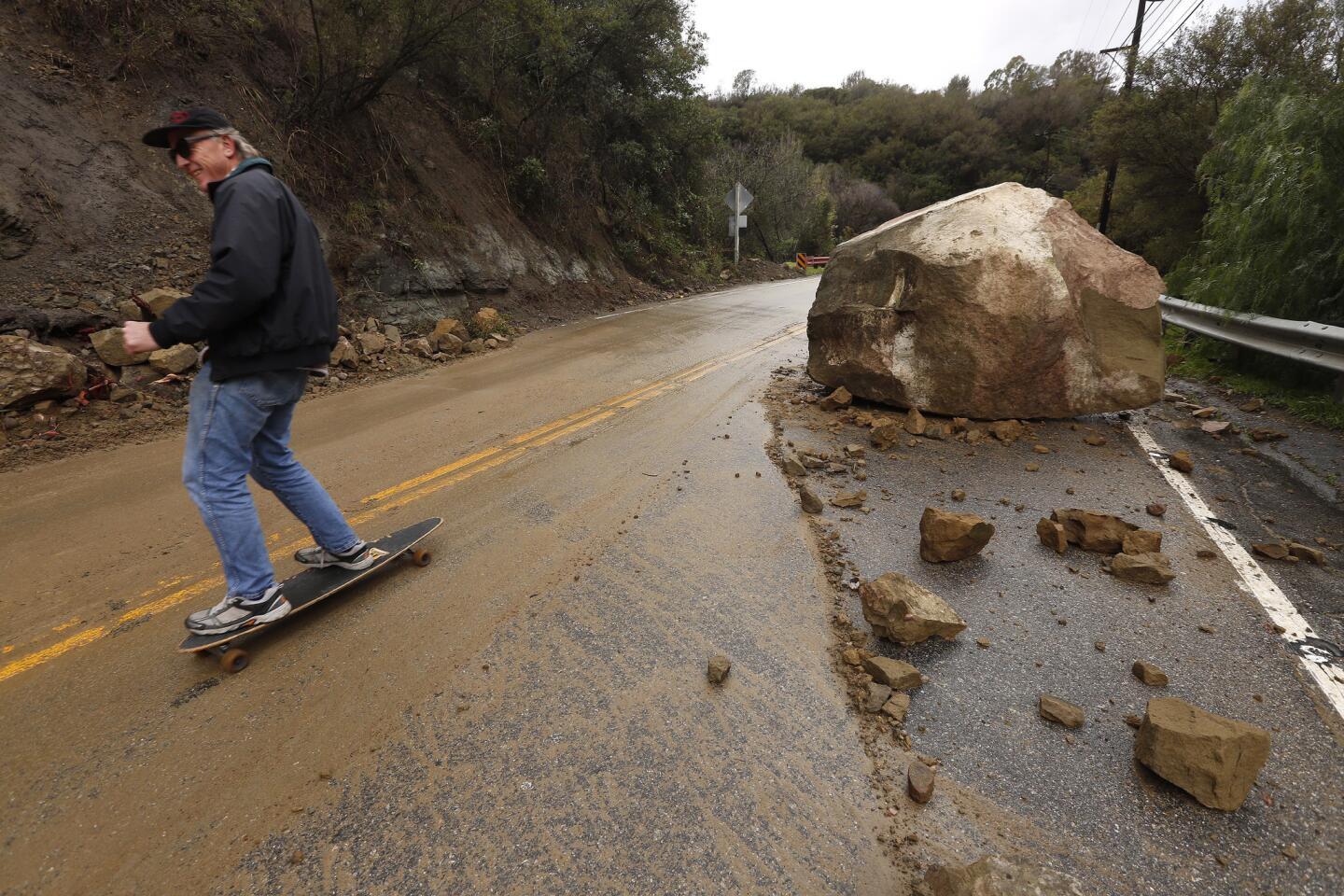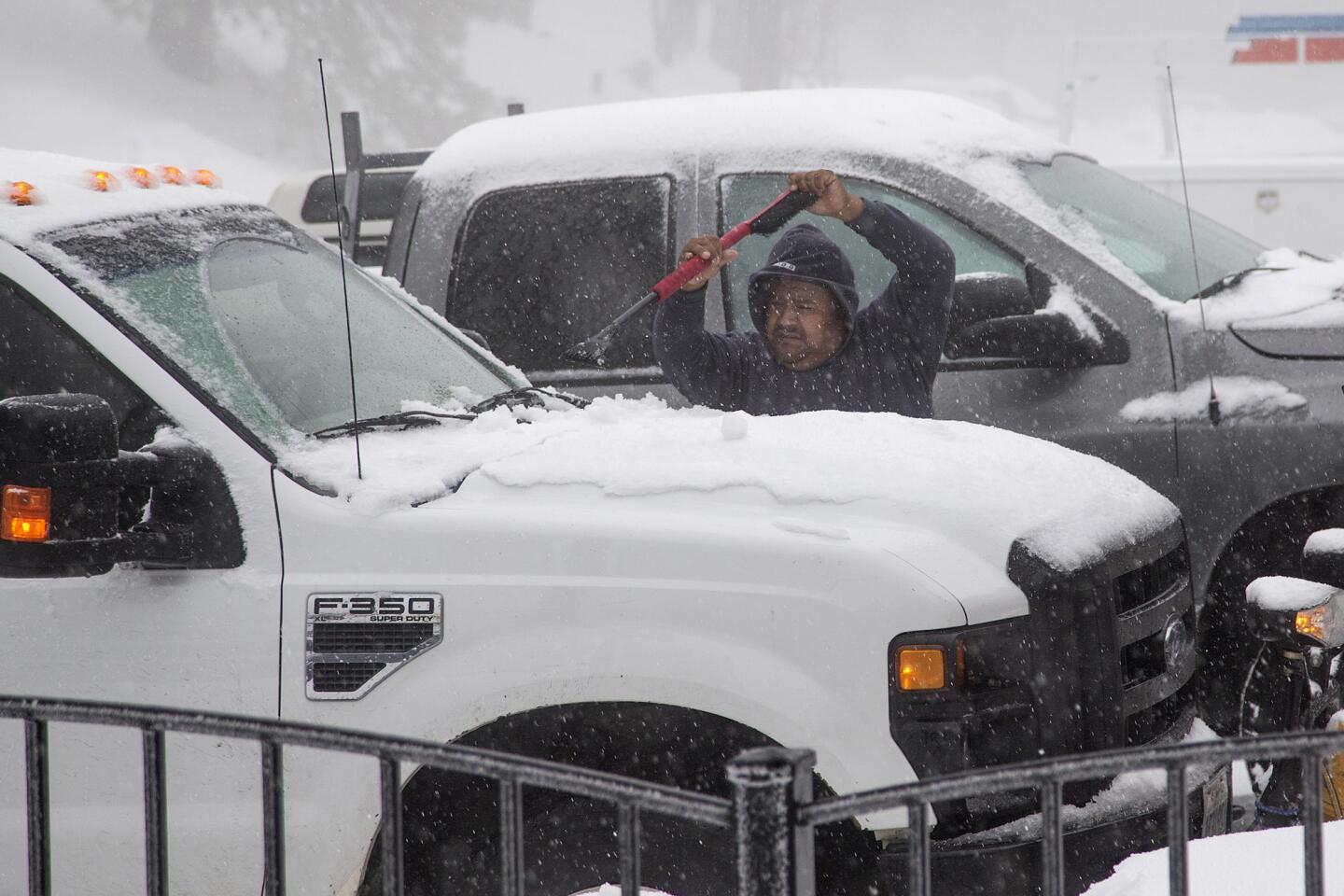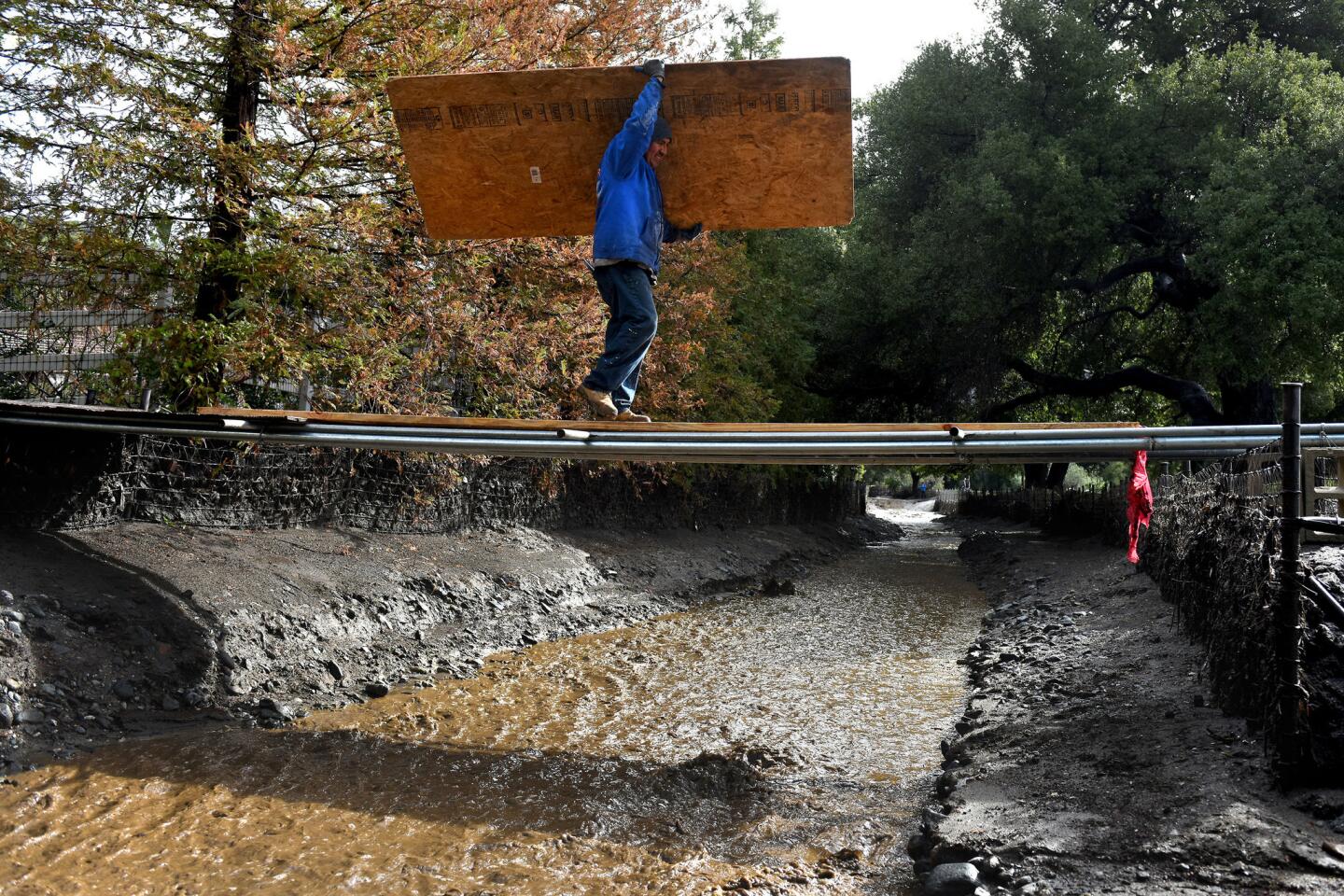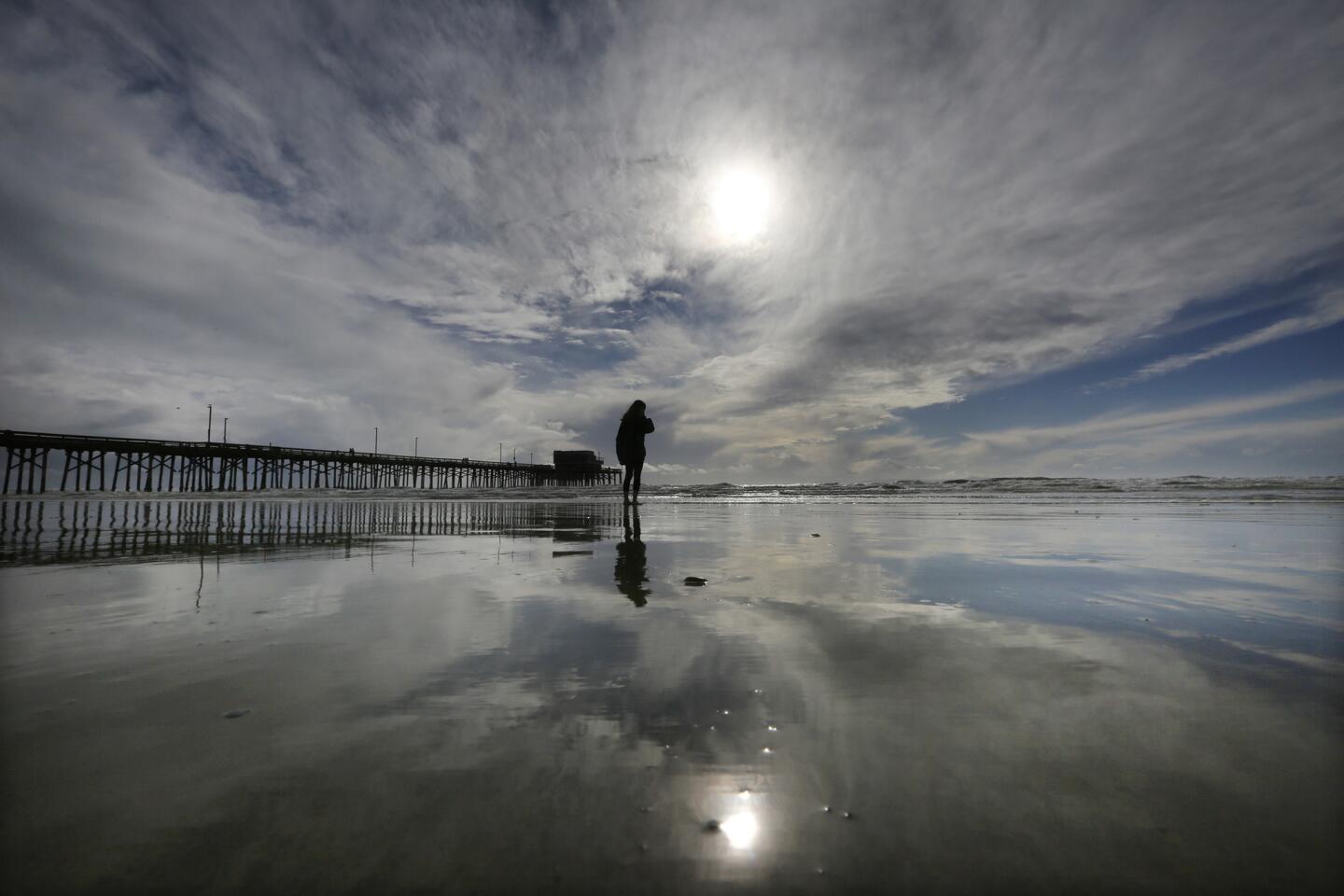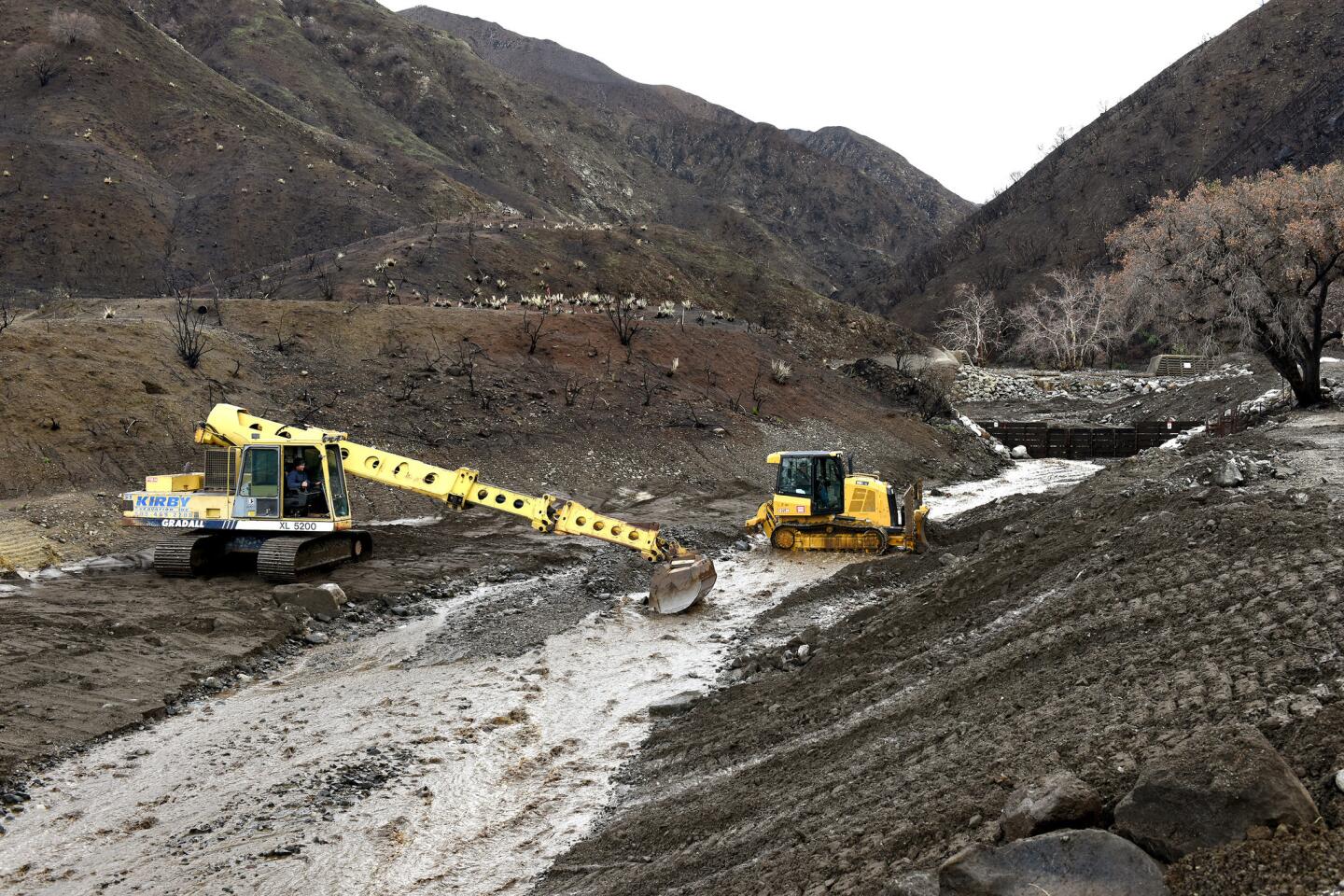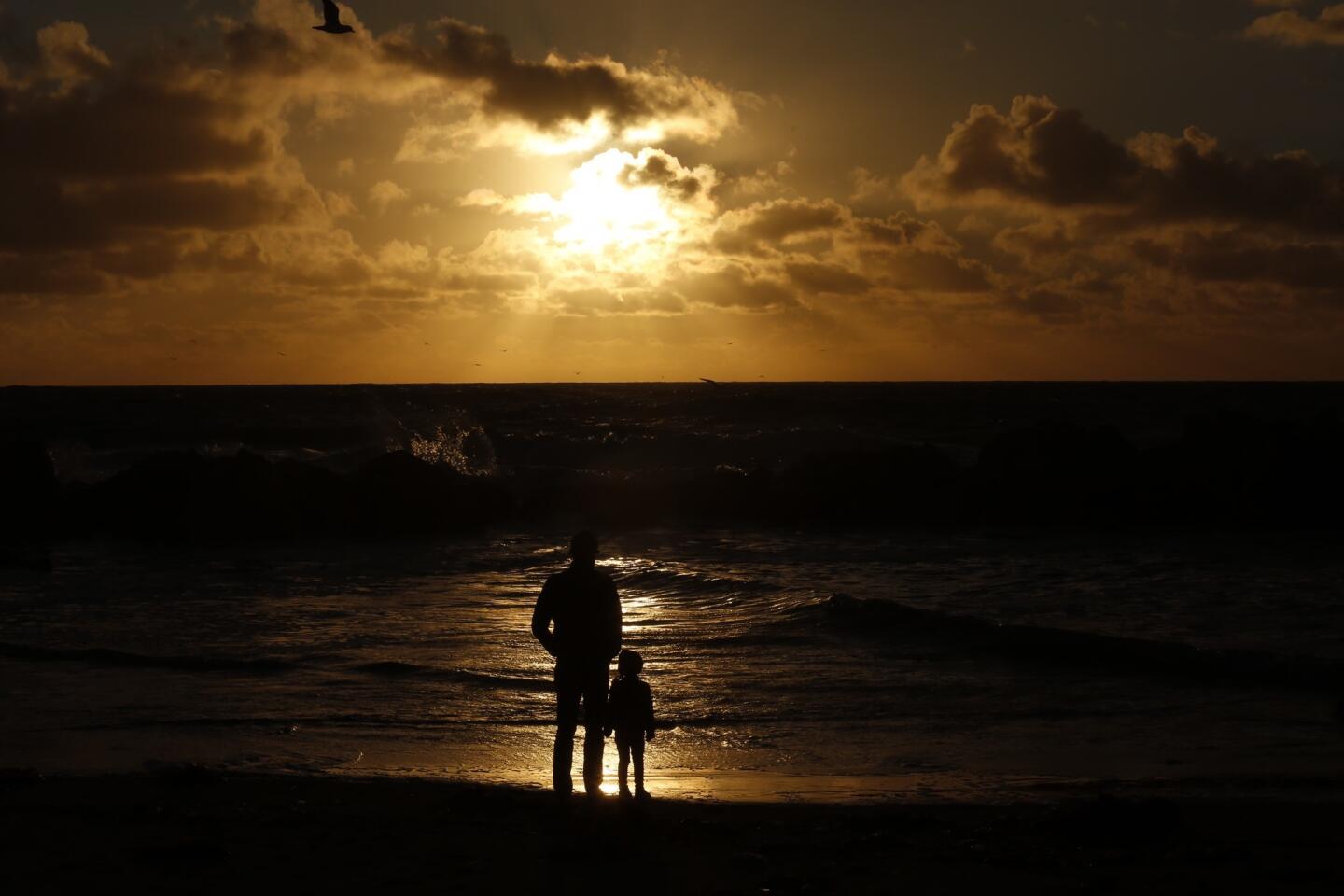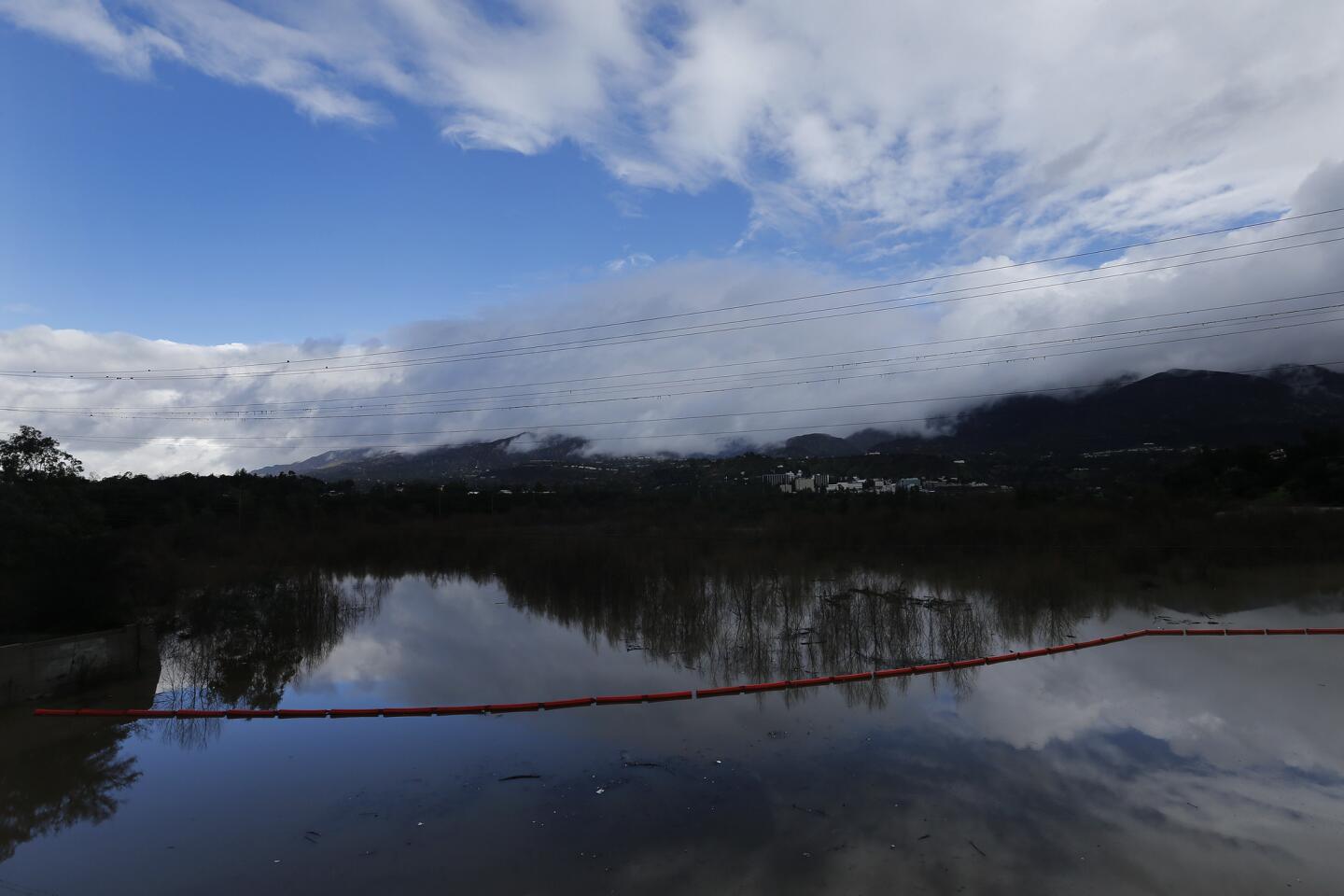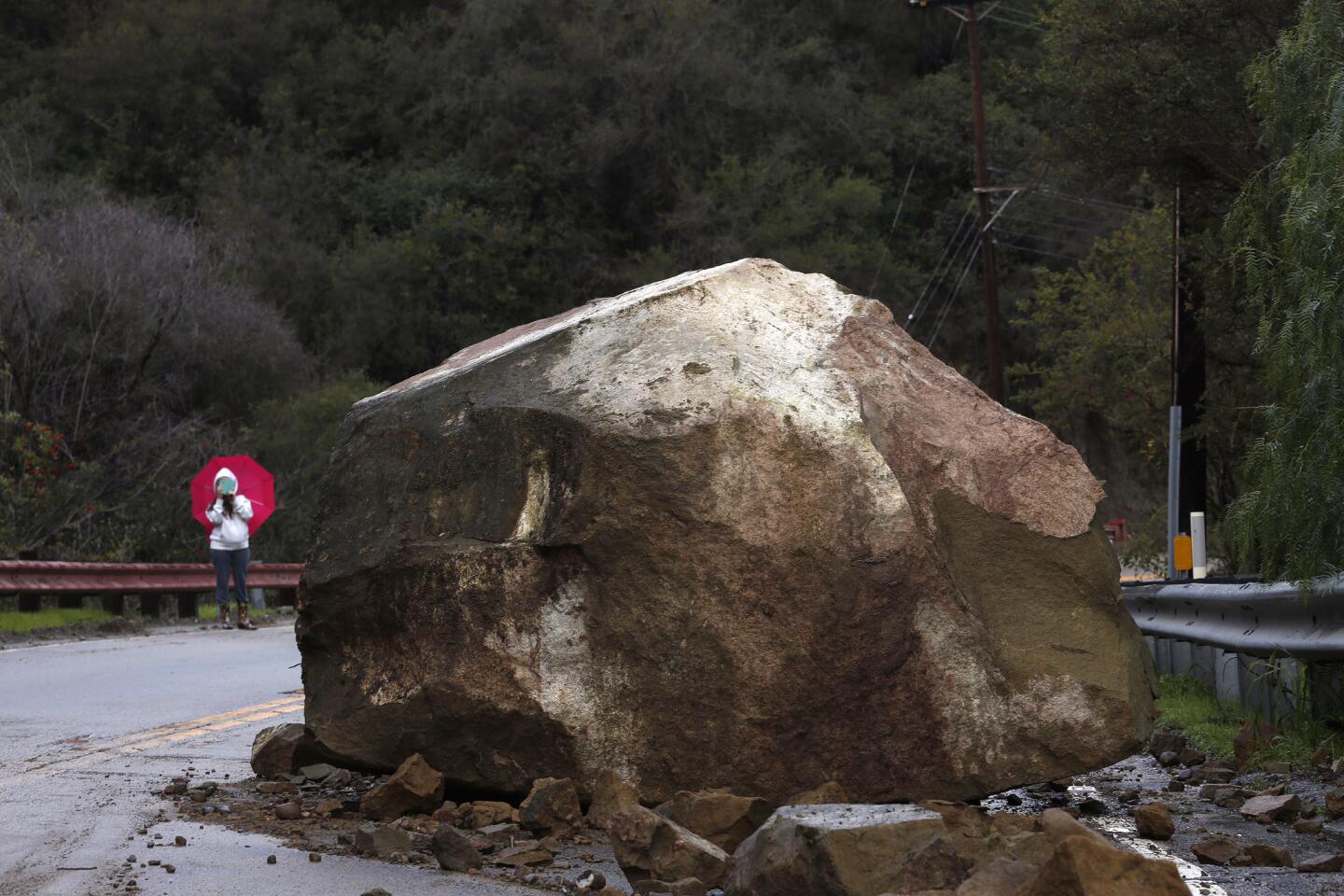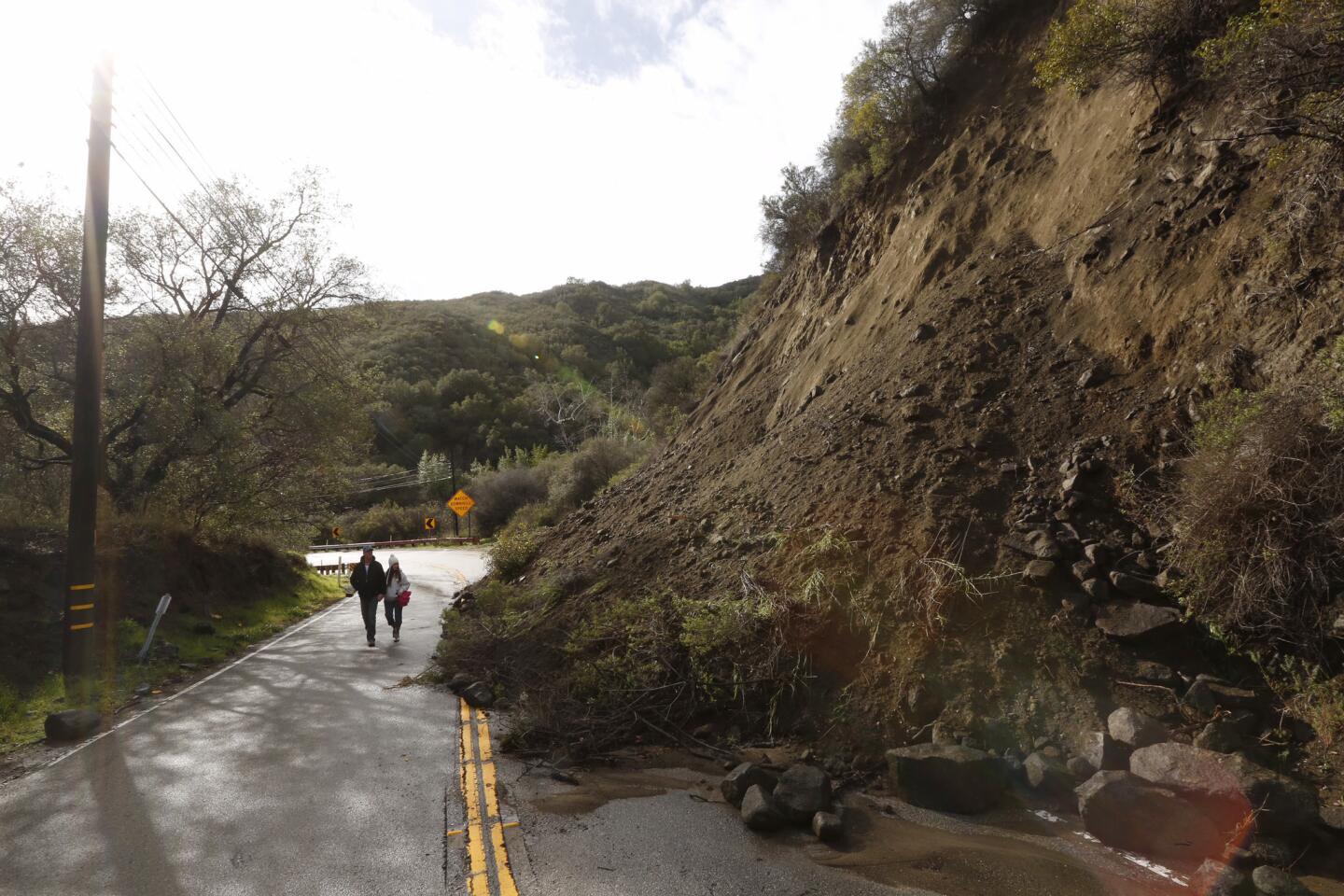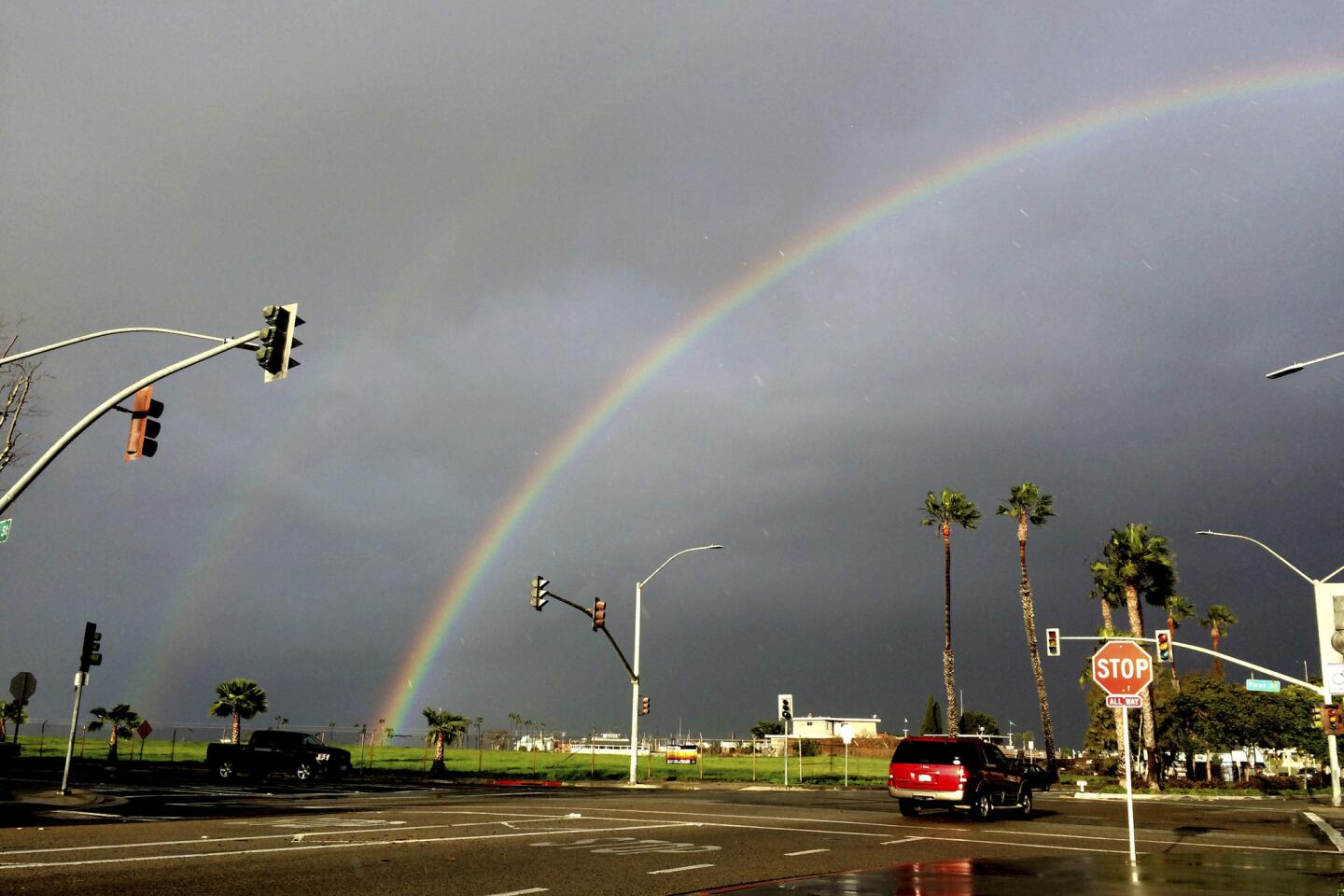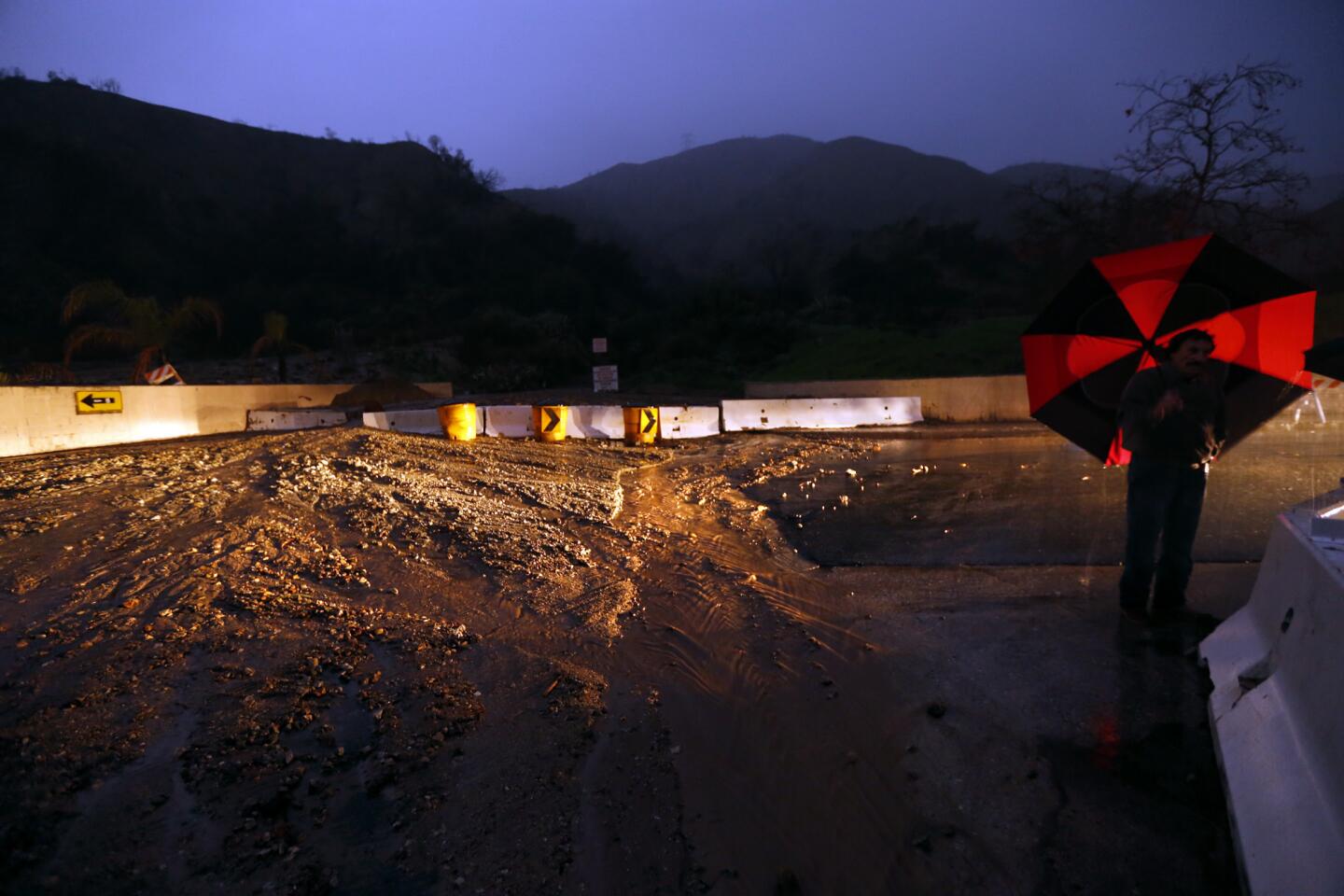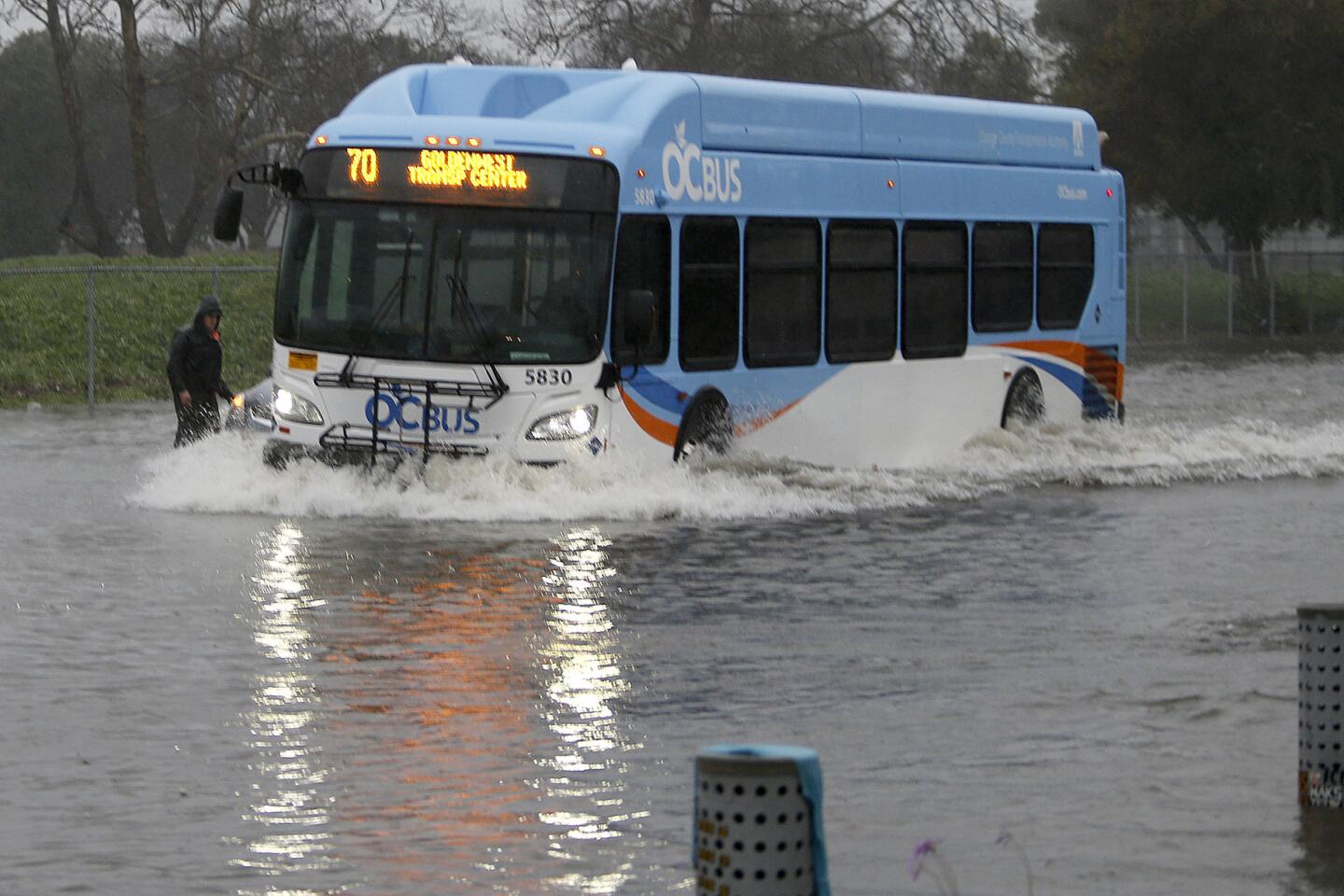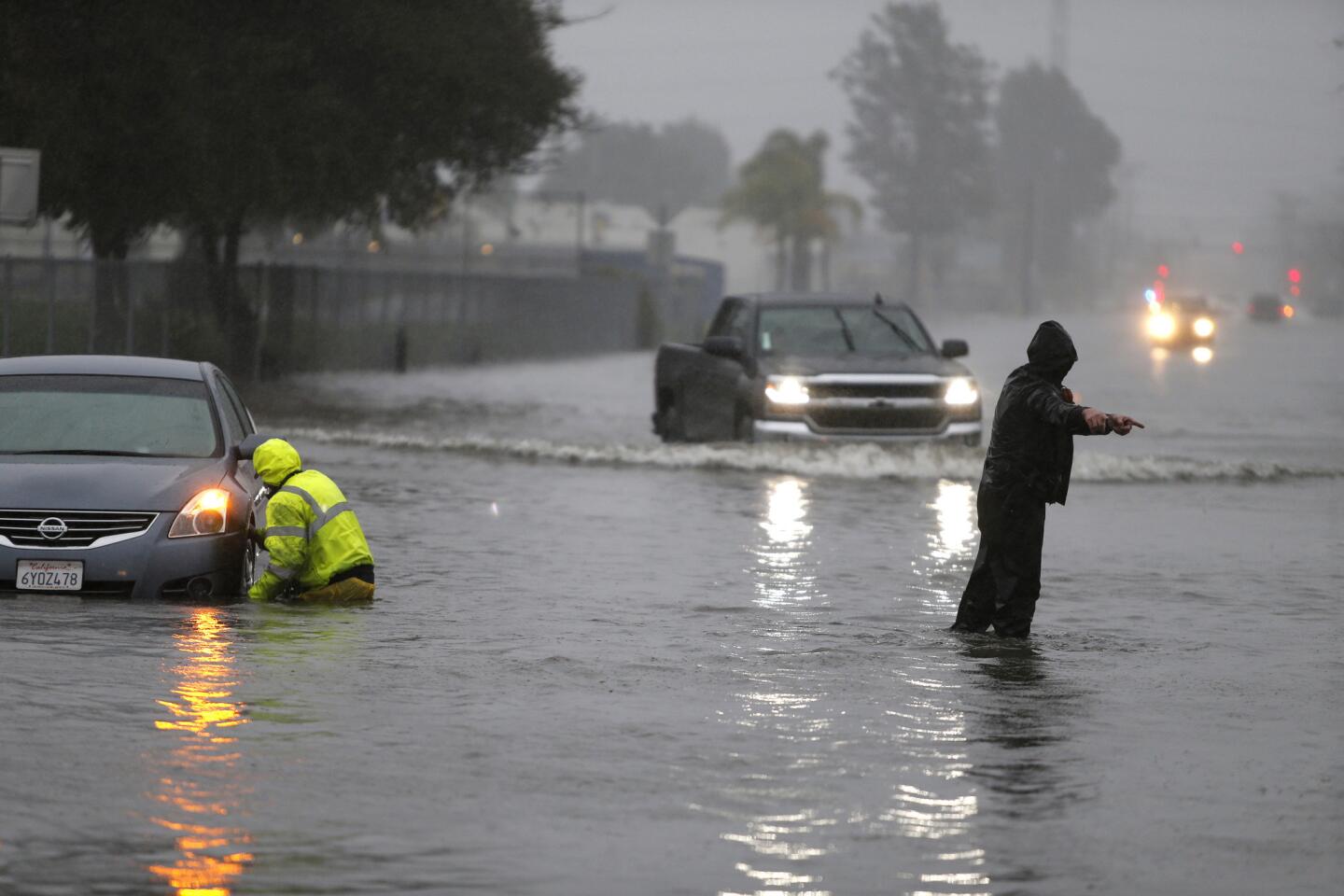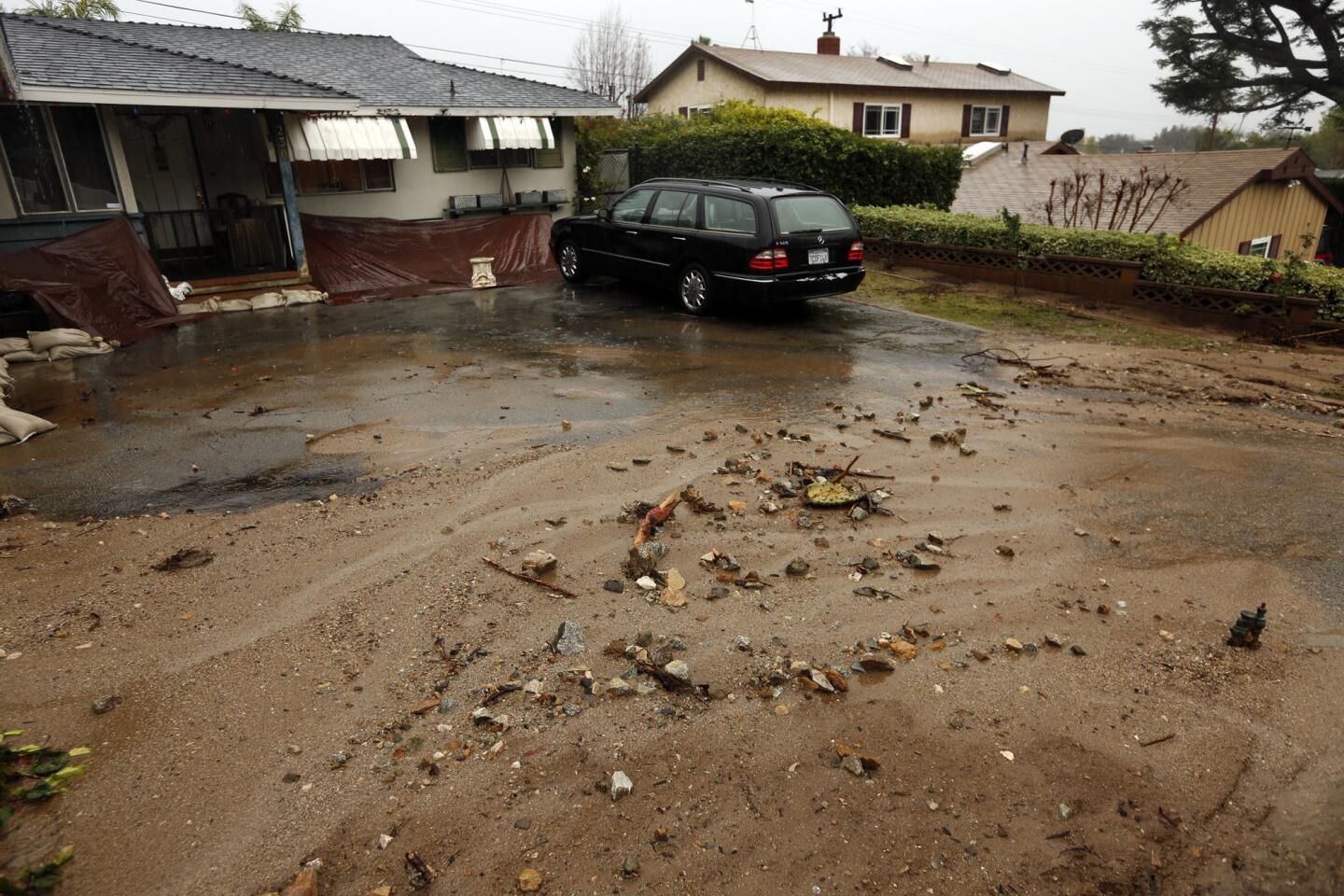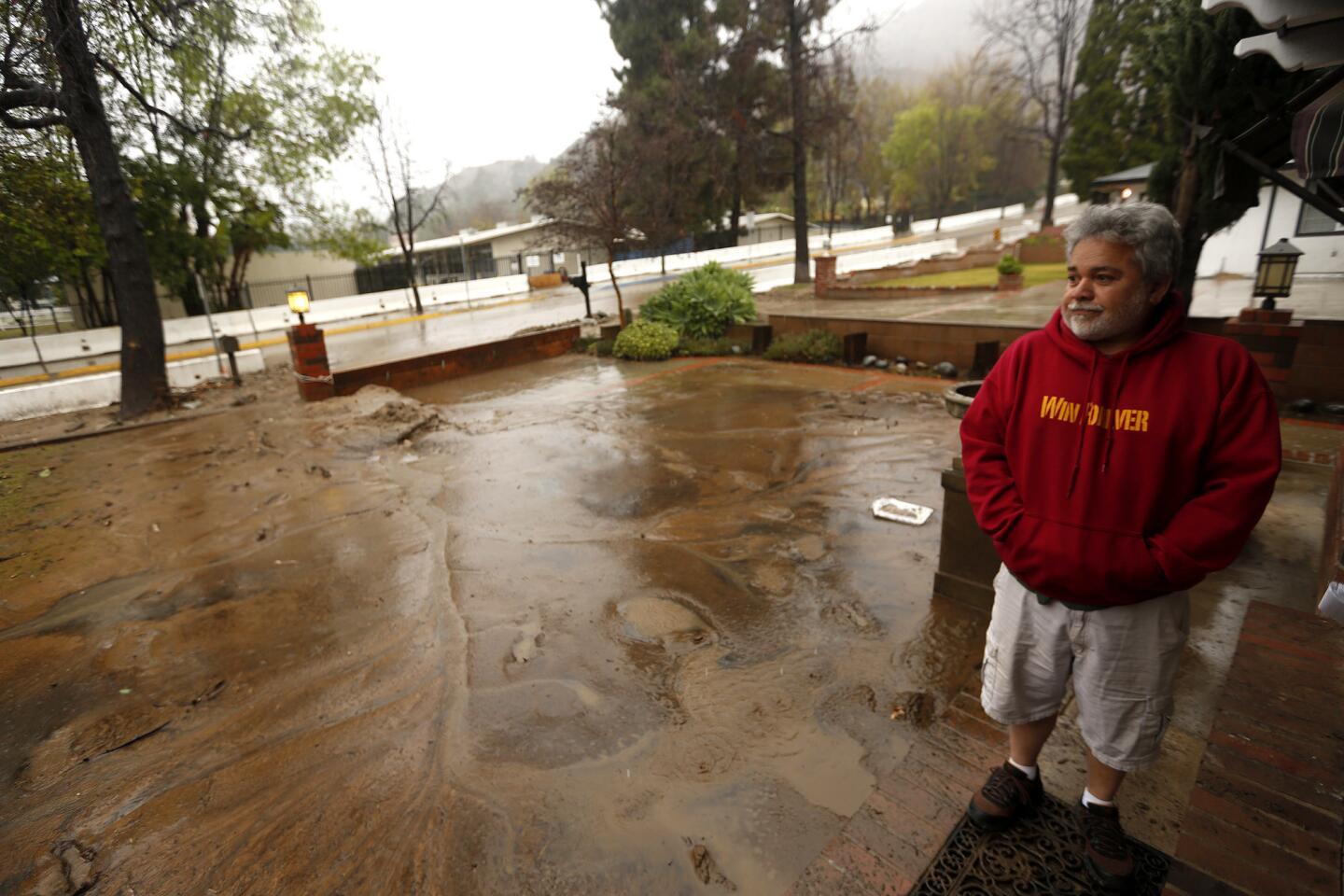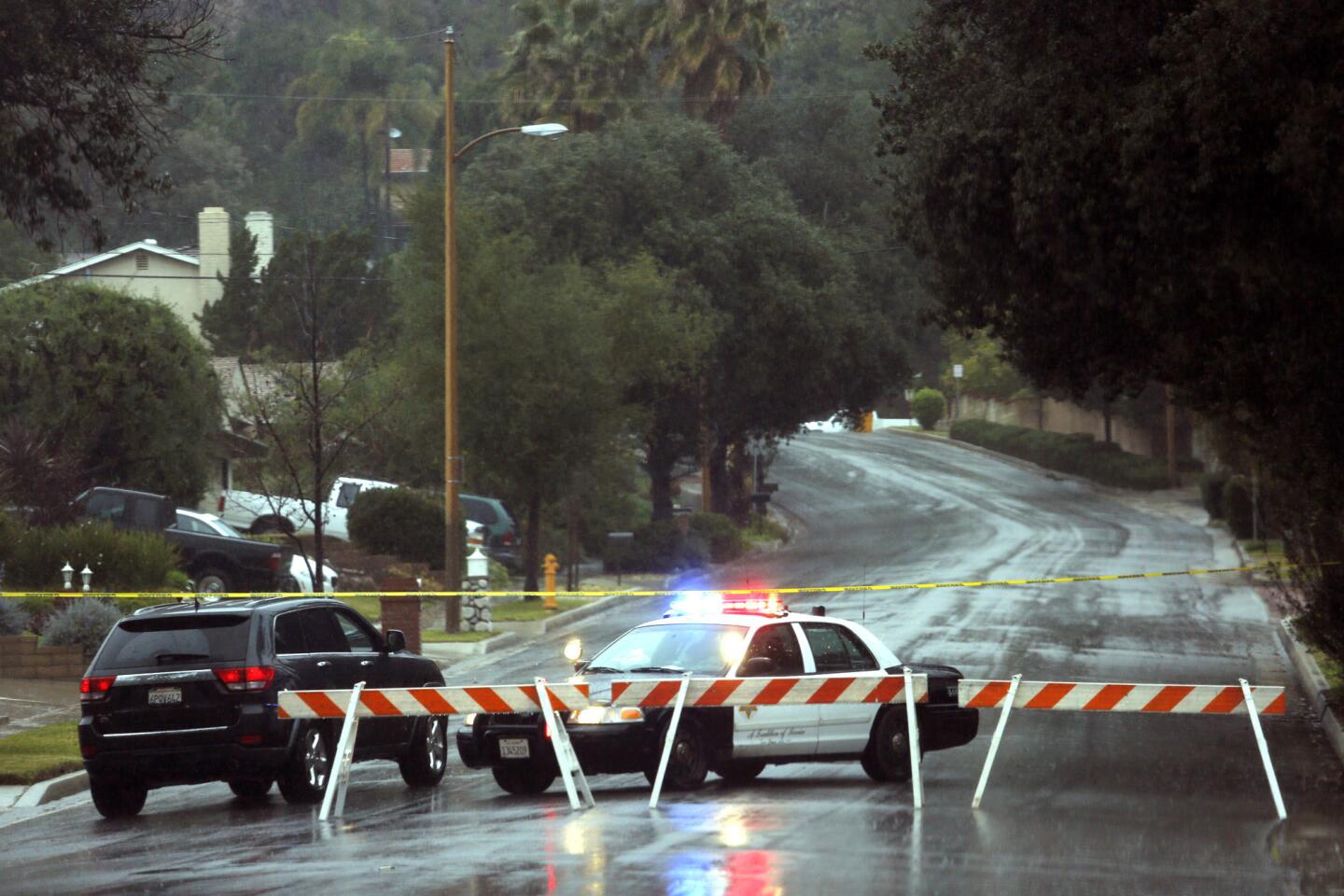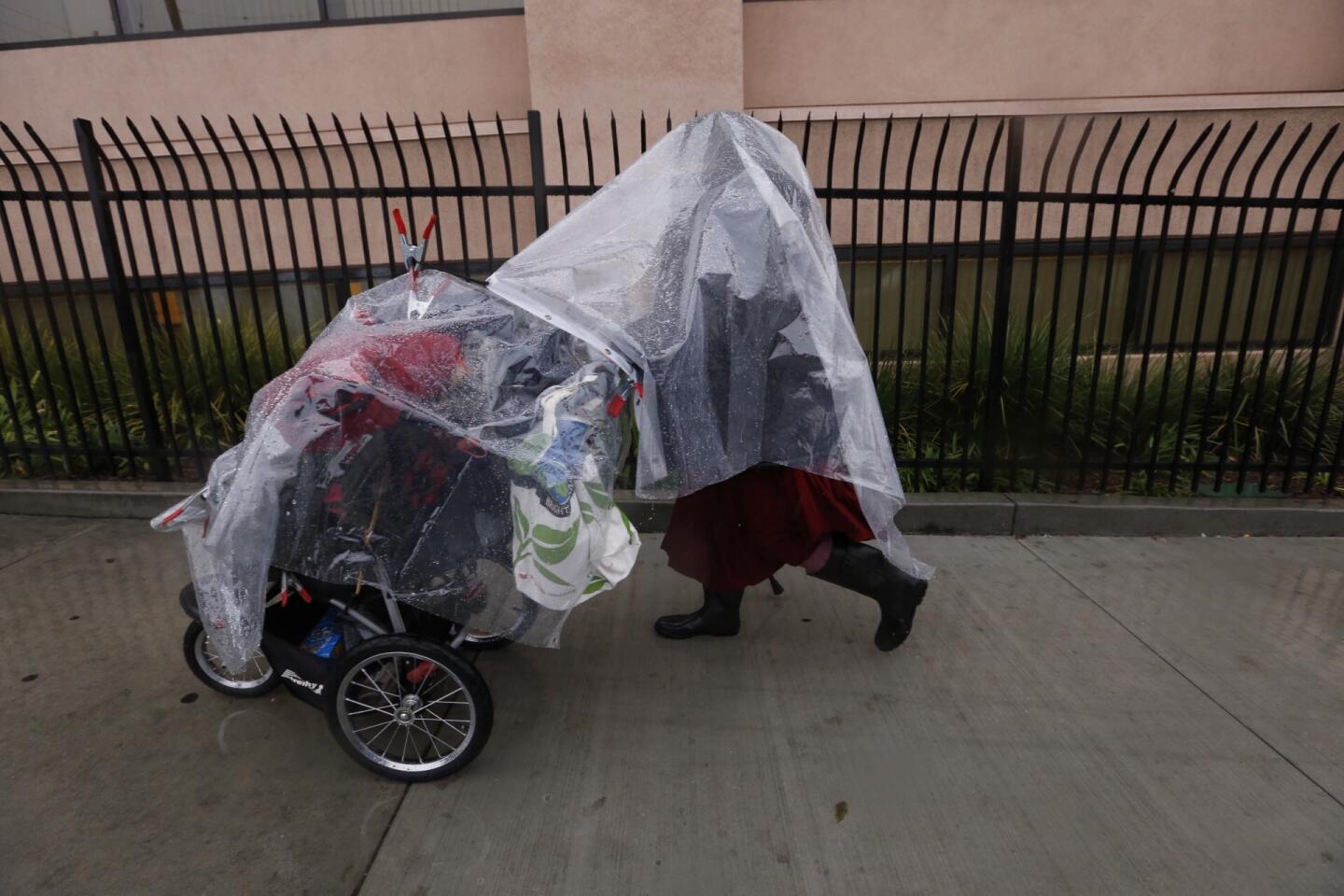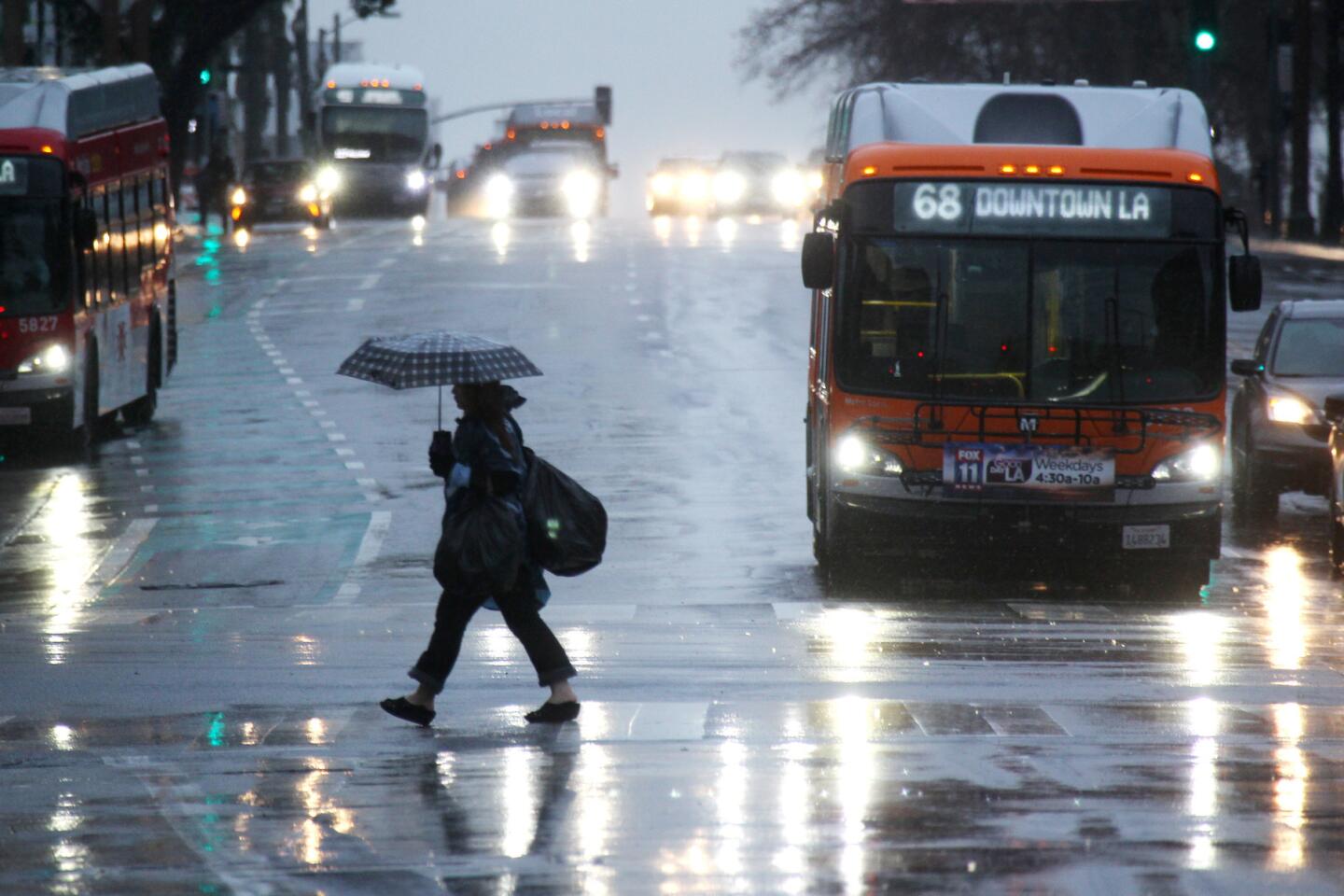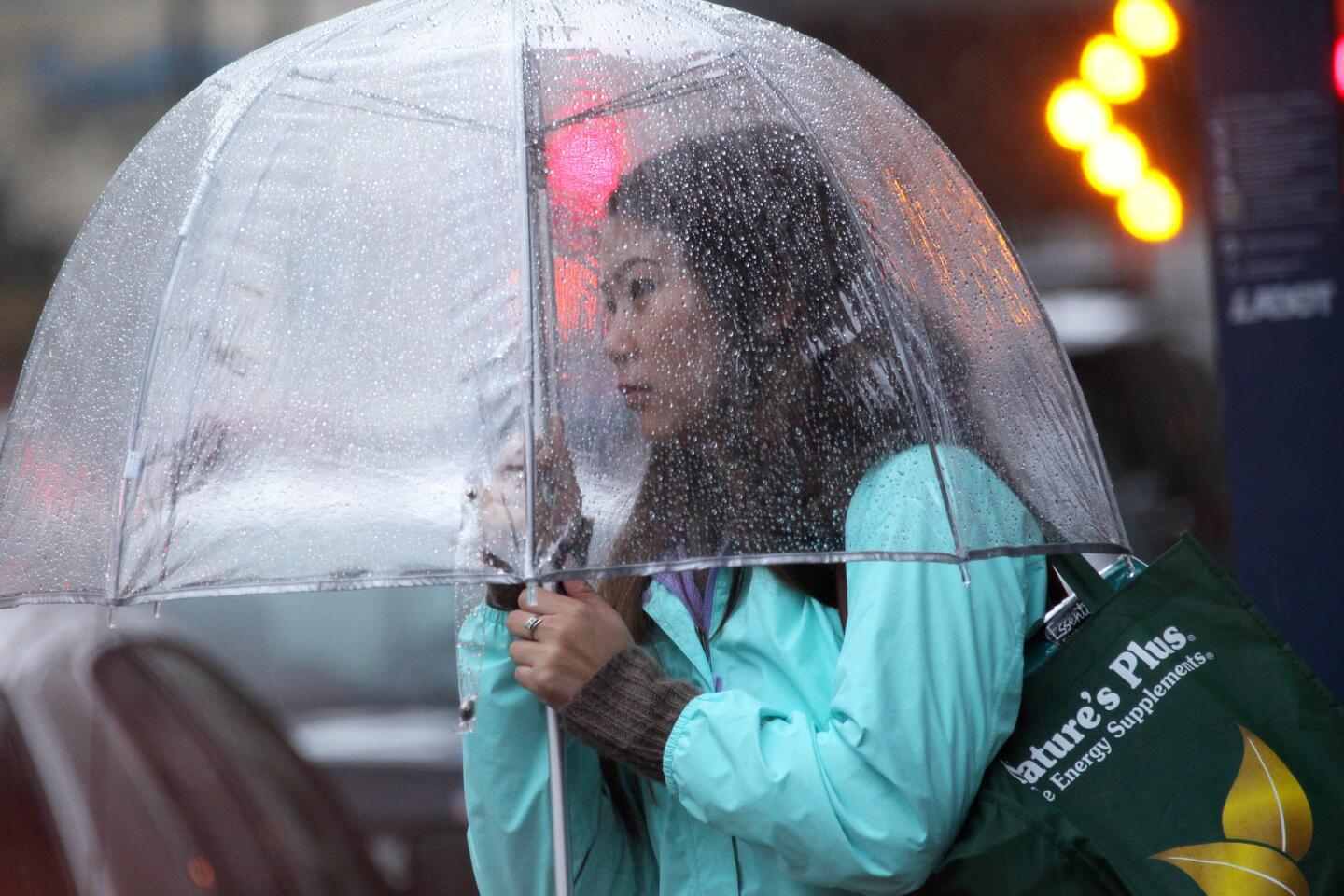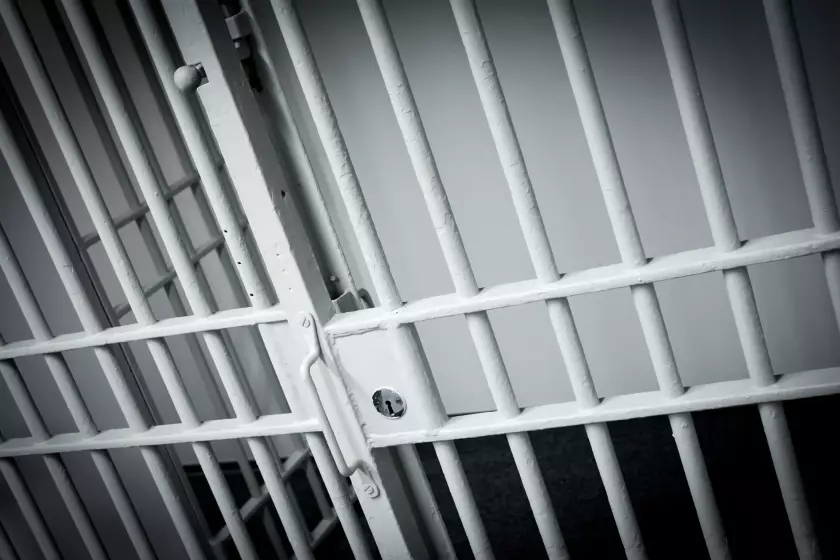According to the latest maps, Southern California is still in a drought.
But the dry conditions that have mired the region for more than five years have definitely shifted — at least for now.
Sunday’s huge storm — which dumped nearly 4 inches of rain in some areas — is part of a wetter trend that began in the fall. Since Oct. 1, downtown L.A. has received more than 13 inches of rain -- 216% of normal for this period, which the National Weather Service said was 6.26 inches.
It’s a remarkable turnaround.
A series of storms that drenched the Southland over the weekend left debris and clean-up in places like Seal Beac, Long Beach Malibu and Pasadena.
Over the summer, the National Weather Service announced that the past five years were the driest ever in downtown L.A. since official record keeping began almost 140 years ago. Precipitation during those five years totaled just 38.79 inches — roughly half of normal.
1/43
A car is stuck in standing water on the southbound 110 Freeway on Jan. 22. (Christina House / For The Times)
2/43
A surfer barely clears a giant wave in Manhattan Beach.
(Genaro Molina / Los Angeles Times) 3/43
People enjoy the snow in Acton.
(Michael Owen Baker / For The Times) 4/43
Elizabeth Wolterbeek plays among rocks in the 200 block of Mel Canyon Road in Duarte on Friday after a mudslide.
(Irfan Khan / Los Angeles Times) 5/43
A girl loses control of her umbrella after being rescued by a Huntington Beach police officer and a tow truck operator. Her family became trapped in their disabled car in the middle of flooded Heil Ave. amid a heavy downpour in Huntington Beach.
(Allen J. Schaben / Los Angeles Times) 6/43
Commuters navigate a rain-soaked 10 Freeway in downtown Los Angeles on Thursday morning, as the first of three storms rolls through Southern California. More storms are expected over the weekend.
(Irfan Khan / Los Angeles Times) 7/43
Palmdale residents Cesar Navarro, left, and his son Cesar Navarro Jr. sled down a snowy hill in Acton.
(Michael Owen Baker / For The Times) 8/43
A fast moving discharge of water spews from the San Gabriel Dam, as a storm front moves through the area.
(Robert Gauthier / Los Angeles Times) 9/43
A bicyclist comes to the end of a trail that’s covered in wet sand at Dockweiler State Beach in Playa del Rey.
(Genaro Molina / Los Angeles Times) 10/43
Snow covers boat slips and a lone picnic at Lake Arrowhead on Monday as the latest strom moves through.
(Gina Ferazzi / Los Angeles Times) 11/43
Debris, including drinking cups, rubber balls and bottles, washes ashore along the Alamitos Peninsula near East Ocean Boulevard and 56th Place in Long Beach on Monday.
(Mark Boster / Los Angeles Times) 12/43
Dale Ball of La Cañada Flintridge has rain gear for herself and her dogs while walking toward the entrance to Hahamongna Watershed Park in Pasadena on Jan. 23.
(Mel Melcon / Los Angeles Times) 13/43
A car drives through a snowy scene on Shannon Valley Road in Acton.
(Michael Owen Baker / For The Times) 14/43
A city worker uses a snowblower to clear the walkways during a snowstorm at Lake Arrowhead Village.
(Gina Ferazzi / Los Angeles Times) 15/43
With the road closed to traffic, Paul Doolin rides a skateboard past a fallen boulder that rests on Topanga Canyon Blvd.
(Genaro Molina / Los Angeles Times) 16/43
A city worker shovels the walkways during a snowstorm at Lake Arrowhead Village in the San Bernardino mountains.
(Gina Ferazzi / Los Angeles Times) 17/43
Jose Villa of Lake Arrowhead clears fresh snow off his windshield during a blizzard in Rimforest, Calif.
(Gina Ferazzi / Los Angeles Times) 18/43
Snow begins to fall and stick to the road in Crestline, Calif.
(Gina Ferazzi / Los Angeles Times) 19/43
Enrique Nicanor carries plywood on an improvised walkway he made over a flowing creek that damaged the driveway to the house where he works on Iron Canyon Road.
(Michael Owen Baker / For The Times) 20/43
Clearing storm clouds are reflected in the wet sand at low tide in Newport Beach on Monday.
(Mark Boster / Los Angeles Times) 21/43
County of Los Angeles pubic works equipment clears the flooded creek on Iron Canyon Road.
(Michael Owen Baker / For The Times) 22/43
Niklas Hofverberg and his daughter Bianca Hofverberg, 3 1/2 years old, watch the sun set as storms clouds dissipate in Venice on Monday.
(Genaro Molina / Los Angeles TImes) 23/43
John Fisher of Altadena looks out toward Devils Gate Reservoir in Pasadena on Jan. 23.
(Mel Melcon / Los Angeles Times) 24/43
Westminster resident Shirley Hansen carries her dog Scruffy while she walks through floodwater caused by recent rain on the boardwalk in Seal Beach.
(Mark Boster / Los Angeles Times) 25/43
A glimpse of blue sky is seen during a break in the rain at Devil’s Gate Reservoir in Pasadena on Jan. 23.
(Mel Melcon / Los Angeles Times) 26/43
Gina Picciolo takes a picture of a boulder that fell onto Topanga Canyon Blvd. Picciolo is a longtime resident in the area.
(Genaro Molina / Los Angeles Times) 27/43
Ward Preston and Gina Picciolo walk past a mudslide along Topanga Canyon Blvd.
(Genaro Molina / Los Angeles Times) 28/43
A Huntington Beach police officer watches a tow truck operator hook up chains to rescue a family from the middle of flooded Heil Avenue after their car stalled in the deep water amid a heavy downpour in Huntington Beach on Jan. 22.
(Allen J. Schaben / Los Angeles Times) 29/43
A rainbow appears over Seal Beach, Calif. on Monday. The tail end of a punishing winter storm system lashed California with thunderstorms and severe winds Monday after breaking rainfall records, washing out roads and whipping up enormous waves.
(Amy Taxin / Associated Press) 30/43
All lanes of the 110 Freeway from Carson Street to 223rd Street were closed Sunday because of flooding. (Christina House / For The Times)
31/43
Jerry Katz stands next to a mudflow at the corner of Mel Canyon and Brookridge roads in Duarte.
(Genaro Molina / Los Angeles Times) 32/43
A Huntington Beach police officer watches a bus drive through flooded Heil Avenue amid a heavy downpour in Huntington Beach.
(Allen J. Schaben / Los Angeles Times) 33/43
A man looks for a safe way to cross floodwaters flowing from hillsides in a nearby recent burn area on North Iron Canyon Road in Santa Clarita.
(Brian van der Brug / Los Angeles Times) 34/43
A Huntington Beach police officer diverts a pickup driver while a tow truck operator hooks up chains to rescue a family from the middle of flooded Heil Ave.
(Allen J. Schaben / Los Angeles Times) 35/43
Mud and rocks have filled the driveway of a Duarte home along Mel Canyon Road, where residents have been evacuated due to mudslides.
(Genaro Molina / Los Angeles Times) 36/43
Rudy Fuentes stands on the porch of his home on Mel Canyon Road in Duarte, looking out at where mud has taken over his driveway.
(Genaro Molina / Los Angeles Times) 37/43
Police stop traffic on Mountain Crest Road where residents have been evacuated due to incoming storms in the Fish fire impact area in Duarte.
(Genaro Molina / Los Angeles Times) 38/43
Marcus Jenkins selling umbrellas as he shelters under one of his own on Hollywood Blvd in Hollywood as the second of three winter storms begin to drench the Southland Friday.
(Al Seib / Los Angeles Times) 39/43
Motorists navigate the flooded lanes of northbound Fairview Street in Santa Ana.
(Mark Boster / Los Angeles Times) 40/43
Ella Masa, all wrapped in plastic, pushes her two service dogs as she joins an East LA/Boyle Heights group with banners and posters marching from Mariachi Plaza on Friday, protesting President Trump’s inauguration.
(Al Seib / Los Angeles Times) 41/43
Umbrellas are necessary on Hollywood Boulevard as the second of three winter storms begins to batter Southern California on Friday morning.
(Al Seib / Los Angeles Times) 42/43
A pedestrian scurries across the street under her umbrella in downtown Los Angeles on Friday morning.
(Irfan Khan / Los Angeles Times) 43/43
Paulina Tu takes cover under her umbrella as she waits for a ride in downtown Los Angeles on Friday morning.
(Irfan Khan / Los Angeles Times) Forecasters had predicted a wet 2016 fueled by El Niño, but the big storms never materialized.
Until recently, officials were seeing a divergence in the state. Storms in Northern California were quickly easing the drought. But the drought persisted in Southern California.
According to the U.S. Drought Monitor, swaths of Northern California are now out of drought due to pounding storms that replenished the Sierra snowpack and filled reservoirs.
Since Oct. 1, total precipitation in the Sierra Nevada has been soaring at rates similar to the wettest winters in the modern record: 1982-83 in the northern and central Sierra and 1968-69 in the southern Sierra.
As of last week, Lake Shasta, the state’s largest reservoir and a major source of water for San Joaquin Valley agriculture, is 82% full and releasing water to create more storage room. Oroville, which supplies the State Water Project, is 77% full and also making releases.
A vast swath of Southern and Central California — from Orange County to Tulare County — remains mired in “extreme” drought conditions, according to federal officials.
Officials have warned California’s water shortage is expected to continue for some time, especially in the south, which relies on Sierra snowpack but also other sources for its water.
The big question is how long will these wet conditions continued in the Southland.
Sunday’s storm was one for the record books, flooding streets and freeways and dumping more than 3 inches of rain in numerous communities from Long Beach through Garden Grove and Yorba Linda.
Long Beach got more than 4 inches, setting an all-time record. Redondo Beach got 3.44 inches.
“It’s not a normal event. It was definitely a culmination of the perfect circumstances: We had a very intense atmospheric river with a lot of moisture and an area of lift in the atmosphere right over coastal Los Angeles and Orange counties. It forced all of that moisture out,” said Brett Albright, a meteorologist with the National Weather Service’s office in San Diego.
Thunderstorms and flash flooding were possible throughout the region on Monday before clearing begins.
ALSO
One for the books: Here are some records this storm has blown past
Widespread flooding, mudslides, evacuations as biggest storm in years batters California
Raging rivers, flooded freeways and a very wet Disneyland — scenes from Southern California’s powerful storm
UPDATES:
9:29 a.m.: This post was updated with new rain totals from the National Weather Service.
This post was originally published at 8:15 a.m.

